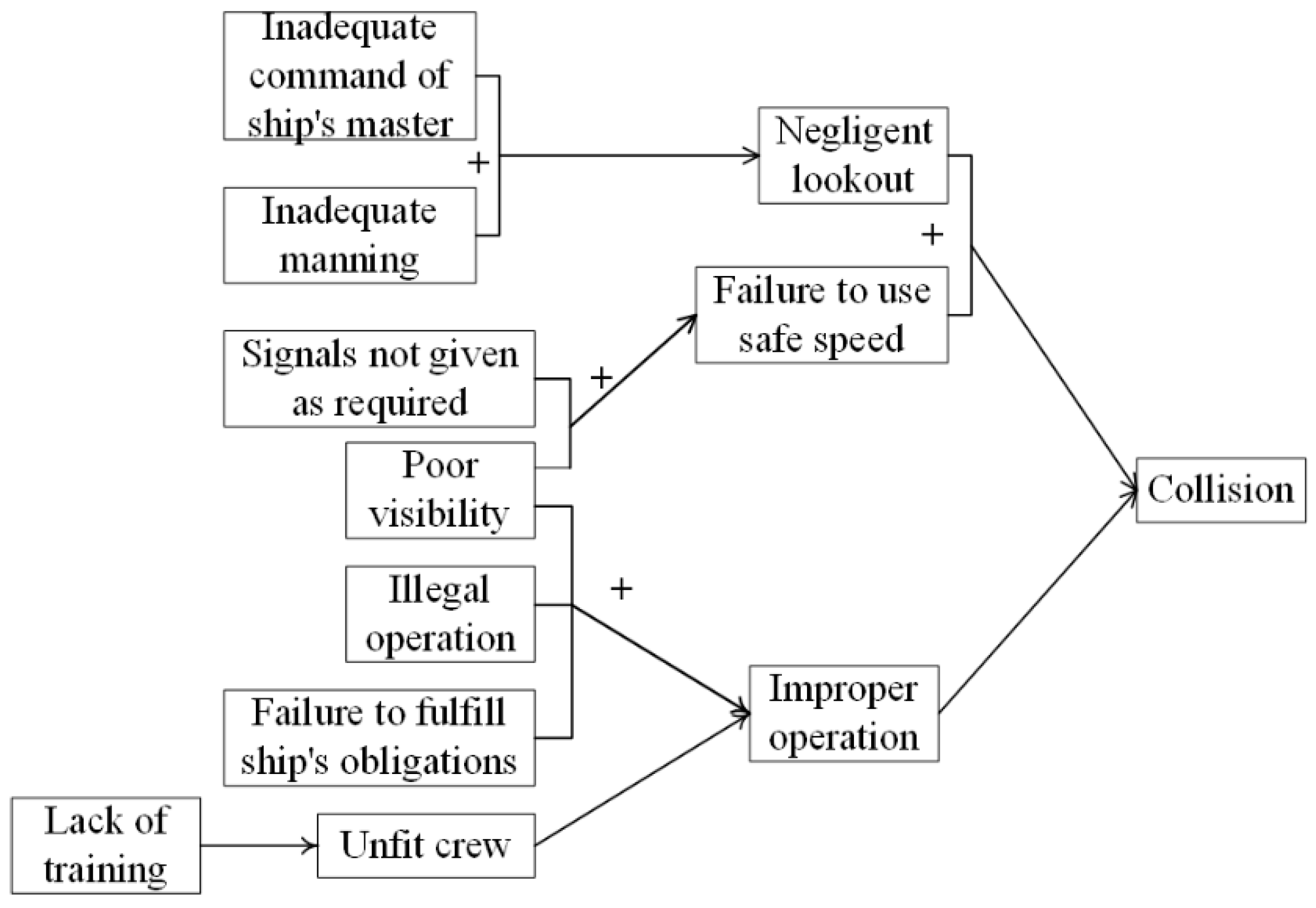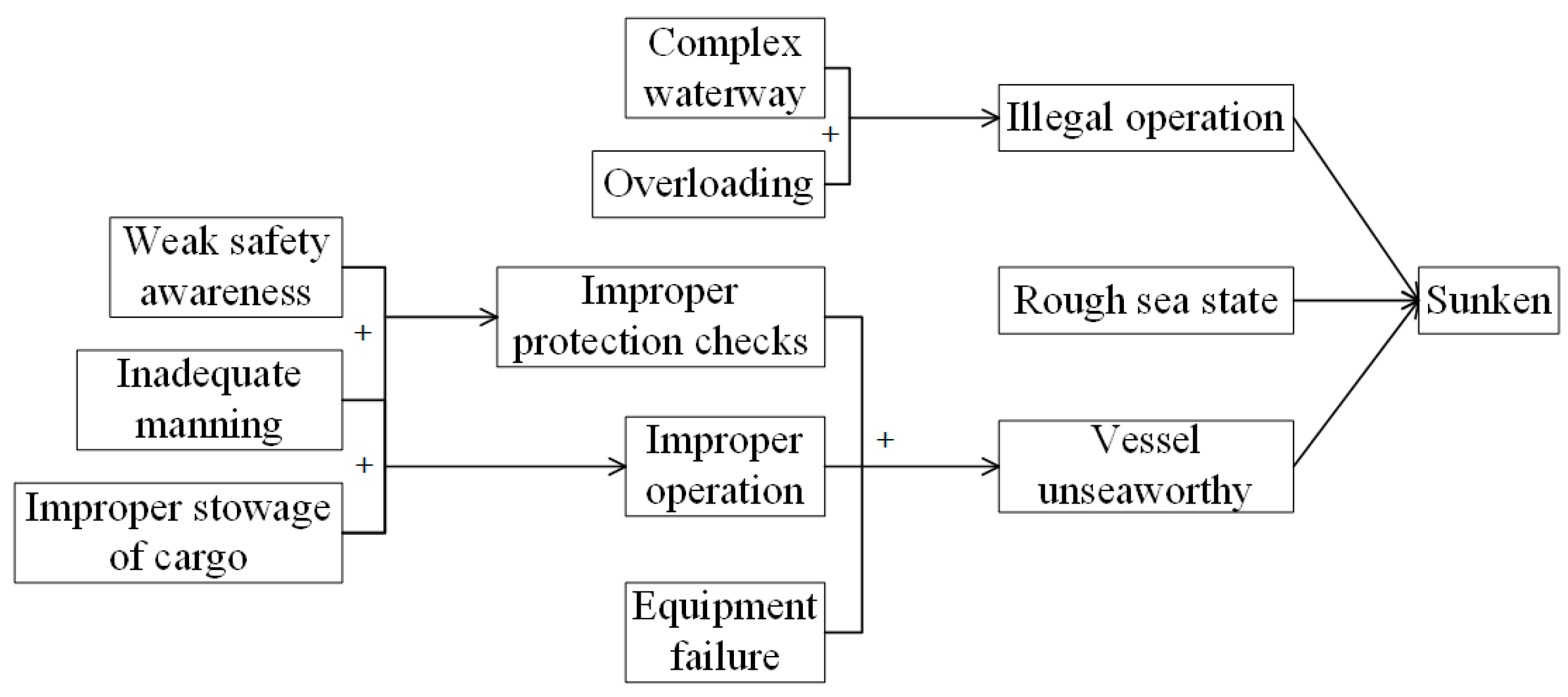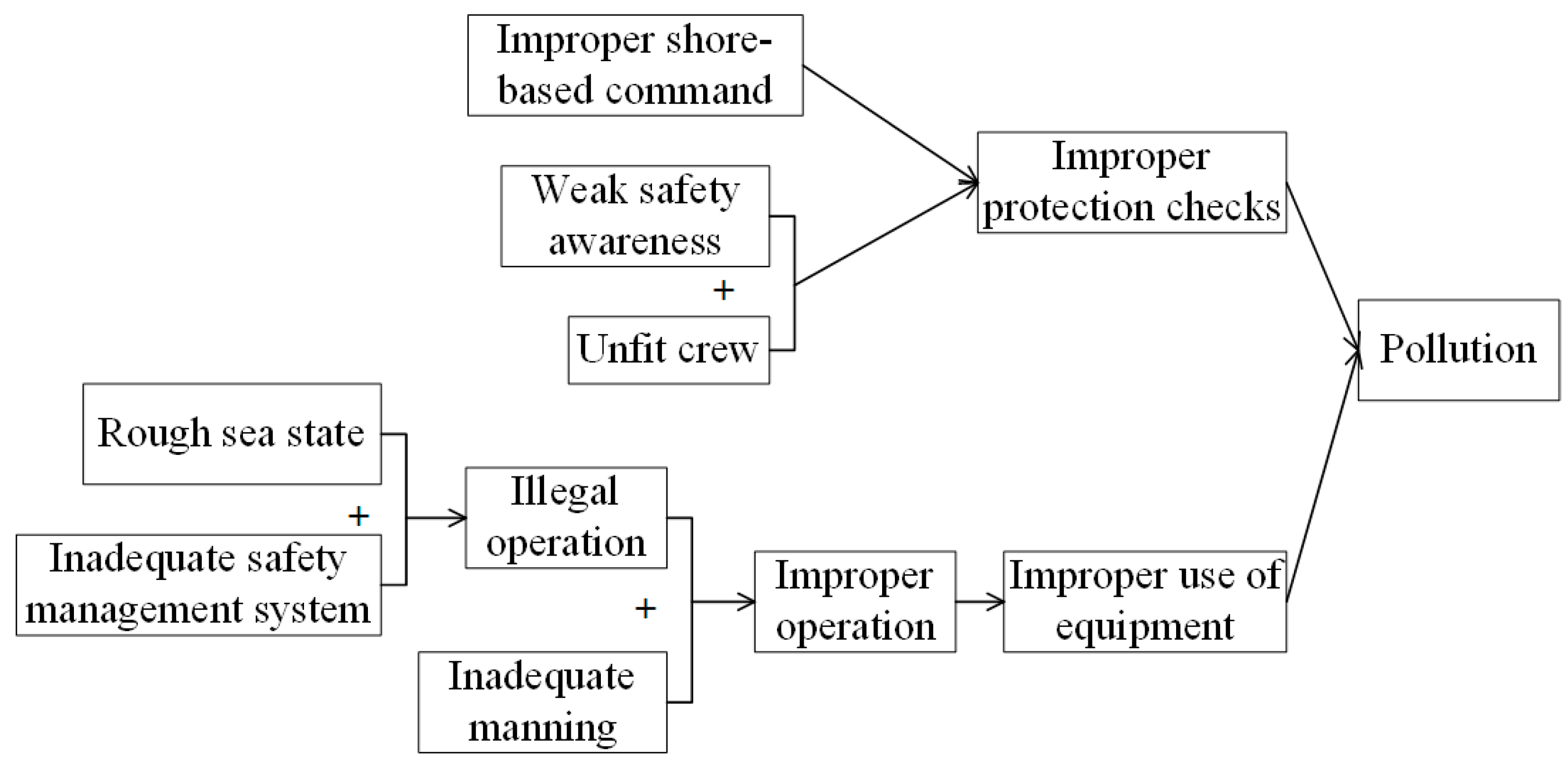Causation Analysis of Marine Traffic Accidents Using Deep Learning Approaches: A Case Study from China’s Coasts
Abstract
:1. Introduction
2. Literature Review
2.1. Investigation into Causative Factors
2.2. Investigation into Causative Methodologies
3. Methodology
3.1. BERT + BiLSTM Classification Model
3.1.1. BERT
- (1)
- Input Layer
- (2)
- Embedding layer
- (3)
- Transformer Encoder Layer
3.1.2. BiLSTM
3.2. Apriori Algorithm
3.3. Framework
4. Case Study
4.1. Data
4.2. Modeling
4.2.1. Loss Function and Accuracy
4.2.2. Confusion Matrix
4.3. Classification Results
4.4. Apriori Association Results
- (1)
- The most widespread causes
- (2)
- Sorting of strong association rules
5. Discussion
5.1. Model Comparison
5.2. Apriori Algorithm Analysis
5.2.1. Complex Network Analysis
5.2.2. Accident Causation Chain
- (1)
- (2)
- (3)
5.3. Analysis of Accident Information
5.3.1. Accident Level and Areas
5.3.2. Type of Accident
5.3.3. Seasonal Influences
5.4. Improvements
6. Conclusions
Author Contributions
Funding
Data Availability Statement
Acknowledgments
Conflicts of Interest
| 1 | https://commercial.allianz.com/content/dam/onemarketing/commercial/commercial/reports/ Allianz Global Corporate & Specialty (AGCS) -Safety-Shipping-Review-2023.pdf. |
References
- Veitch, E.; Alsos, O.A. A systematic review of human-AI interaction in autonomous ship systems. Saf. Sci. 2022, 152, 105778. [Google Scholar] [CrossRef]
- Ministry of Transport of the People’s Republic of China. Transport Sector Development Bulletin 2023; Ministry of Transport of the People’s Republic of China: Beijing, China, 2024. [Google Scholar]
- Li, M.; Mou, J.; Chen, P.; Chen, L.; Van Gelder, P. Real-time collision risk based safety management for vessel traffic in busy ports and waterways. Ocean. Coast. Manag. 2023, 234, 106471. [Google Scholar] [CrossRef]
- Wang, H.; Liu, Z.; Wang, X.; Graham, T.; Wang, J. An analysis of factors affecting the severity of marine accidents. Reliab. Eng. Syst. Saf. 2021, 210, 107513. [Google Scholar] [CrossRef]
- Zhang, H.; Chen, B.; Zhao, Q.; Yu, J.; Fang, Z. Identification of risk key factors and prevention strategies for collision accidents between merchant and fishing vessels in China waters based on complex network. Ocean Eng. 2024, 307, 118148. [Google Scholar] [CrossRef]
- Deng, J.; Liu, S.; Xie, C.; Liu, K. Risk coupling characteristics of maritime accidents in Chinese inland and coastal waters based on NK model. J. Mar. Sci. Eng. 2021, 10, 4. [Google Scholar] [CrossRef]
- Magklasi, I. Safety of ship to ship transfers and investigation of marine accidents: An evaluation of the UK MAIB reports. J. Int. Marit. Law 2022, 28, 91–105. [Google Scholar]
- Bhardwaj, U.; Teixeira, A.; Soares, C.G. Casualty analysis methodology and taxonomy for FPSO accident analysis. Reliab. Eng. Syst. Saf. 2022, 218, 108169. [Google Scholar] [CrossRef]
- Chowdhury, M.N.; Shafi, S.; Arzaman, M.; Farhan, A.; Teoh, B.A.; Kadhim, K.A.; Salamun, H.; Abdul Kadir, F.K.; Said, S.; Kadir, K.A. Navigating Human Factors in Maritime Safety: A Review of Risks and Improvements in Engine Rooms of Ocean-Going Vessels. Int. J. Saf. Secur. Eng. 2024, 14, 1–14. [Google Scholar] [CrossRef]
- Hu, S.; Li, Z.; Xi, Y.; Gu, X.; Zhang, X. Path analysis of causal factors influencing marine traffic accident via structural equation numerical modeling. J. Mar. Sci. Eng. 2019, 7, 96. [Google Scholar] [CrossRef]
- Kokotos, D.X.; Linardatos, D.S. An application of data mining tools for the study of shipping safety in restricted waters. Saf. Sci. 2011, 49, 192–197. [Google Scholar] [CrossRef]
- Cao, Y.; Wang, X.; Wang, Y.; Fan, S.; Wang, H.; Yang, Z.; Liu, Z.; Wang, J.; Shi, R. Analysis of factors affecting the severity of marine accidents using a data-driven Bayesian network. Ocean Eng. 2023, 269, 113563. [Google Scholar] [CrossRef]
- Islam, R.; Khan, F.; Abbassi, R.; Garaniya, V. Human error probability assessment during maintenance activities of marine systems. Saf. Health Work 2018, 9, 42–52. [Google Scholar] [CrossRef]
- Kimera, D.; Nangolo, F.N. Reliability maintenance aspects of deck machinery for ageing/aged fishing vessels. J. Mar. Eng. Technol. 2022, 21, 100–110. [Google Scholar] [CrossRef]
- Antão, P.; Sun, S.; Teixeira, A.; Soares, C.G. Quantitative assessment of ship collision risk influencing factors from worldwide accident and fleet data. Reliab. Eng. Syst. Saf. 2023, 234, 109166. [Google Scholar] [CrossRef]
- Chen, P.; Huang, Y.; Mou, J.; Van Gelder, P. Probabilistic risk analysis for ship-ship collision: State-of-the-art. Saf. Sci. 2019, 117, 108–122. [Google Scholar] [CrossRef]
- Chen, J.; Bian, W.; Wan, Z.; Yang, Z.; Zheng, H.; Wang, P. Identifying factors influencing total-loss marine accidents in the world: Analysis and evaluation based on ship types and sea regions. Ocean Eng. 2019, 191, 106495. [Google Scholar] [CrossRef]
- Lin, Q.; Yin, B.; Zhang, X.; Grifoll, M.; Feng, H. Evaluation of ship collision risk in ships’ routeing waters: A Gini coefficient approach using AIS data. Phys. A Stat. Mech. Its Appl. 2023, 624, 128936. [Google Scholar] [CrossRef]
- Jon, M.H.; Kim, Y.P.; Choe, U. Determination of a safety criterion via risk assessment of marine accidents based on a Markov model with five states and MCMC simulation and on three risk factors. Ocean Eng. 2021, 236, 109000. [Google Scholar] [CrossRef]
- Bye, R.J.; Aalberg, A.L. Maritime navigation accidents and risk indicators: An exploratory statistical analysis using AIS data and accident reports. Reliab. Eng. Syst. Saf. 2018, 176, 174–186. [Google Scholar] [CrossRef]
- Wang, L.; Yang, Z. Bayesian network modelling and analysis of accident severity in waterborne transportation: A case study in China. Reliab. Eng. Syst. Saf. 2018, 180, 277–289. [Google Scholar] [CrossRef]
- New Zealand Journal of ScienceZhang, G.; Thai, V.V.; Yuen, K.F.; Loh, H.S.; Zhou, Q. Addressing the epistemic uncertainty in maritime accidents modelling using Bayesian network with interval probabilities. Saf. Sci. 2018, 102, 211–225. [Google Scholar] [CrossRef]
- Khan, R.U.; Yin, J.; Mustafa, F.S.; Anning, N. Risk assessment for berthing of hazardous cargo vessels using Bayesian networks. Ocean Coast. Manag. 2021, 210, 105673. [Google Scholar] [CrossRef]
- Animah, I. Application of bayesian network in the maritime industry: Comprehensive literature review. Ocean Eng. 2024, 302, 117610. [Google Scholar] [CrossRef]
- Li, K.X.; Yin, J.; Bang, H.S.; Yang, Z.; Wang, J. Bayesian network with quantitative input for maritime risk analysis. Transp. A Transp. Sci. 2014, 10, 89–118. [Google Scholar] [CrossRef]
- Chin, H.C.; Debnath, A.K. Modeling perceived collision risk in port water navigation. Saf. Sci. 2009, 47, 1410–1416. [Google Scholar] [CrossRef]
- Feng, H.; Grifoll, M.; Yang, Z.; Zheng, P. Collision risk assessment for ships’ routeing waters: An information entropy approach with Automatic Identification System (AIS) data. Ocean Coast. Manag. 2022, 224, 106184. [Google Scholar] [CrossRef]
- Melnyk, O.; Petrov, I.; Melenchuk, T.; Zaporozhets, A.; Bugaeva, S.; Rossomakha, O. Causal Model and Cluster Analysis of Marine Incidents: Risk Factors and Preventive Strategies. In Maritime Systems, Transport and Logistics I: Safety and Efficiency of Operation; Springer: Cham, Switzerland, 2025; pp. 89–105. [Google Scholar]
- Kececi, T.; Arslan, O. SHARE technique: A novel approach to root cause analysis of ship accidents. Saf. Sci. 2017, 96, 1–21. [Google Scholar] [CrossRef]
- Chen, D.; Pei, Y.; Xia, Q. Research on human factors cause chain of ship accidents based on multidimensional association rules. Ocean Eng. 2020, 218, 107717. [Google Scholar] [CrossRef]
- Ma, L.; Ma, X.; Lan, H.; Liu, Y.; Deng, W. A data-driven method for modeling human factors in maritime accidents by integrating DEMATEL and FCM based on HFACS: A case of ship collisions. Ocean Eng. 2022, 266, 112699. [Google Scholar] [CrossRef]
- Li, Z.; Zhou, L.; Yang, X.; Jia, H.; Li, W.; Zhang, J. User sentiment analysis of Covid-19 via adversarial training based on the BERT-FGM-BiGRU model. Systems 2023, 11, 129. [Google Scholar] [CrossRef]
- Journal of Marine Science and TechnologyPerboli, G.; Gajetti, M.; Fedorov, S.; Giudice, S.L. Natural Language Processing for the identification of Human factors in aviation accidents causes: An application to the SHEL methodology. Expert Syst. Appl. 2021, 186, 115694. [Google Scholar] [CrossRef]
- Tarshizi, E.; Buche, M.; Inti, B.; Chappidi, R. Text mining analysis of US Department of Labor’s MSHA fatal accident reports for coal mining. Min. Eng. 2018, 70, 43. [Google Scholar] [CrossRef]
- Liu, D.; Wang, X.; Cai, Y.; Liu, Z.; Liu, Z.-J. A novel framework of real-time regional collision risk prediction based on the RNN approach. J. Mar. Sci. Eng. 2020, 8, 224. [Google Scholar] [CrossRef]
- Gan, L.; Gao, Z.; Zhang, X.; Xu, Y.; Liu, R.W.; Xie, C.; Shu, Y. Graph neural networks enabled accident causation prediction for maritime vessel traffic. Reliab. Eng. Syst. Saf. 2025, 257, 110804. [Google Scholar] [CrossRef]
- Chen, J.; Zhuang, C.; Shi, J.; Jiang, H.; Xu, J.; Liu, J. Risk factors extraction and analysis of Chinese ship collision accidents based on knowledge graph. Ocean Eng. 2025, 322, 120536. [Google Scholar] [CrossRef]
- Gan, L.; Ye, B.; Huang, Z.; Xu, Y.; Chen, Q.; Shu, Y. Knowledge graph construction based on ship collision accident reports to improve maritime traffic safety. Ocean Coast. Manag. 2023, 240, 106660. [Google Scholar] [CrossRef]
- Nurduhan, M.; Kuleyin, B. Cluster-based Visualization of human element interactions in marine accidents. Ocean Eng. 2024, 298, 117153. [Google Scholar] [CrossRef]
- Huang, X.; Wen, Y.; Zhang, F.; Li, H.; Sui, Z.; Cheng, X. Accident analysis of waterway dangerous goods transport: Building an evolution network with text knowledge extraction. Ocean Eng. 2025, 318, 120176. [Google Scholar] [CrossRef]
- Yan, K.; Wang, Y.; Jia, L.; Wang, W.; Liu, S.; Geng, Y. A content-aware corpus-based model for analysis of marine accidents. Accid. Anal. Prev. 2023, 184, 106991. [Google Scholar] [CrossRef]
- Vaswani, A.; Shazeer, N.; Parmar, N.; Uszkoreit, J.; Jones, L.; Gomez, A.N.; Kaiser, Ł.; Polosukhin, I. Attention is all you need. In Proceedings of the 31st International Conference on Neural Information Processing Systems, Long Beach, CA, USA, 4–9 December 2017; pp. 6000–6010. [Google Scholar]
- Kenton, J.D.M.-W.C.; Toutanova, L.K. Bert: Pre-training of deep bidirectional transformers for language understanding. In Proceedings of the 2019 Conference of the North American Chapter of the Association for Computational Linguistics: Human Language Technologies, Volume 1 (Long and Short Papers), Minneapolis, MN, USA, 2–7 June 2019; pp. 4171–4186. [Google Scholar]
- Lv, S.; Lu, S.; Wang, R.; Yin, L.; Yin, Z.; AlQahtani, S.A.; Tian, J.; Zheng, W. Enhancing Chinese Dialogue Generation with Word–Phrase Fusion Embedding and Sparse SoftMax Optimization. Systems 2024, 12, 516. [Google Scholar] [CrossRef]
- Gers, F.A.; Schmidhuber, J.; Cummins, F. Learning to forget: Continual prediction with LSTM. Neural Comput. 2000, 12, 2451–2471. [Google Scholar] [CrossRef] [PubMed]
- Han, J.; Kamber, M.; Pei, J. 6-mining frequent patterns, associations, and correlations: Basic concepts and methods. Data Min. Concepts Tech. 2012, 243–278. [Google Scholar] [CrossRef]
- Guo, M.; Chen, M.; Yuan, L.; Zhang, Z.; Lv, J.; Cai, Z. Investigation of ship collision accident risk factors using BP-DEMATEL method based on HFACS-SCA. Reliab. Eng. Syst. Saf. 2025, 257, 110875. [Google Scholar] [CrossRef]
- Deng, J.; Liu, S.; Shu, Y.; Hu, Y.; Xie, C.; Zeng, X. Risk evolution and prevention and control strategies of maritime accidents in China’s coastal areas based on complex network models. Ocean Coast. Manag. 2023, 237, 106527. [Google Scholar] [CrossRef]
- Shi, J.; Liu, Z.; Feng, Y.; Wang, X.; Zhu, H.; Yang, Z.; Wang, J.; Wang, H. Evolutionary model and risk analysis of ship collision accidents based on complex networks and DEMATEL. Ocean Eng. 2024, 305, 117965. [Google Scholar] [CrossRef]
- Meng, X.; Li, H.; Zhang, W.; Zhou, X.-Y.; Yang, X. Analyzing ship collision accidents in China: A framework based on the NK model and Bayesian networks. Ocean Eng. 2024, 309, 118619. [Google Scholar] [CrossRef]
- Batista, G.E.; Prati, R.C.; Monard, M.C. A study of the behavior of several methods for balancing machine learning training data. ACM SIGKDD Explor. Newsl. 2004, 6, 20–29. [Google Scholar] [CrossRef]
- Kobayashi, S. Contextual augmentation: Data augmentation by words with paradigmatic relations. In Proceedings of the 2018 Conference of the North American Chapter of the Association for Computational Linguistics: Human Language Technologies, Volume 2 (Short Papers), Stent, Amanda; 2018; pp. 452–457. [Google Scholar]
- Sennrich, R.; Haddow, B.; Birch, A. Improving Neural Machine Translation Models with Monolingual Data. In Proceedings of the 54th Annual Meeting of the Association for Computational Linguistics (Volume 1: Long Papers), Berlin, Germany, 7–12 August 2016; pp. 86–96. [Google Scholar]
- Anaby-Tavor, A.; Carmeli, B.; Goldbraich, E.; Kantor, A.; Kour, G.; Shlomov, S.; Tepper, N.; Zwerdling, N. Do not have enough data? Deep learning to the rescue! In Proceedings of the AAAI Conference on Artificial Intelligence, New York, NY, USA, 7–12 February 2020; pp. 7383–7390. [Google Scholar]
- Ousidhoum, N.; Lin, Z.; Zhang, H.; Song, Y.; Yeung, D.-Y. Multilingual and Multi-Aspect Hate Speech Analysis. In Proceedings of the 2019 Conference on Empirical Methods in Natural Language Processing and the 9th International Joint Conference on Natural Language Processing (EMNLP-IJCNLP), Hong Kong, China, 3–7 November 2019; pp. 4675–4684. [Google Scholar]
- Safety ScienceWang, Y.; Fu, S. Framework for Process Analysis of Maritime Accidents Caused by the Unsafe Acts of Seafarers: A Case Study of Ship Collision. J. Mar. Sci. Eng. 2022, 10, 1793. [Google Scholar] [CrossRef]
- Maternová, A.; Materna, M.; Dávid, A.; Török, A.; Švábová, L. Human error analysis and fatality prediction in maritime accidents. J. Mar. Sci. Eng. 2023, 11, 2287. [Google Scholar] [CrossRef]
- Sotiralis, P.; Ventikos, N.P.; Hamann, R.; Golyshev, P.; Teixeira, A. Incorporation of human factors into ship collision risk models focusing on human centred design aspects. Reliab. Eng. Syst. Saf. 2016, 156, 210–227. [Google Scholar] [CrossRef]
- Fan, S.; Blanco-Davis, E.; Fairclough, S.; Zhang, J.; Yan, X.; Wang, J.; Yang, Z. Incorporation of seafarer psychological factors into maritime safety assessment. Ocean Coast. Manag. 2023, 237, 106515. [Google Scholar] [CrossRef]
- Dominguez-Péry, C.; Vuddaraju, L.N.R.; Corbett-Etchevers, I.; Tassabehji, R. Reducing maritime accidents in ships by tackling human error: A bibliometric review and research agenda. J. Shipp. Trade 2021, 6, 20. [Google Scholar] [CrossRef]
- Jiang, M.; Lu, J. Maritime accident risk estimation for sea lanes based on a dynamic Bayesian network. Marit. Policy Manag. 2020, 47, 649–664. [Google Scholar] [CrossRef]
- Zhang, L.; Wang, H.; Meng, Q.; Xie, H. Ship accident consequences and contributing factors analyses using ship accident investigation reports. Proc. Inst. Mech. Eng. Part O J. Risk Reliab. Eng. Syst. Saf. 2019, 233, 35–47. [Google Scholar] [CrossRef]
- Qu, X.; Meng, Q.; Suyi, L. Ship collision risk assessment for the Singapore Strait. Accid. Anal. Prev. 2011, 43, 2030–2036. [Google Scholar] [CrossRef]
- Li, H.; Zhou, K.; Zhang, C.; Bashir, M.; Yang, Z. Dynamic evolution of maritime accidents: Comparative analysis through data-driven Bayesian Networks. Ocean Eng. 2024, 303, 117736. [Google Scholar] [CrossRef]
- Chang, Y.-T.; Park, H. The impact of vessel speed reduction on port accidents. Accid. Anal. Prev. 2019, 123, 422–432. [Google Scholar] [CrossRef]
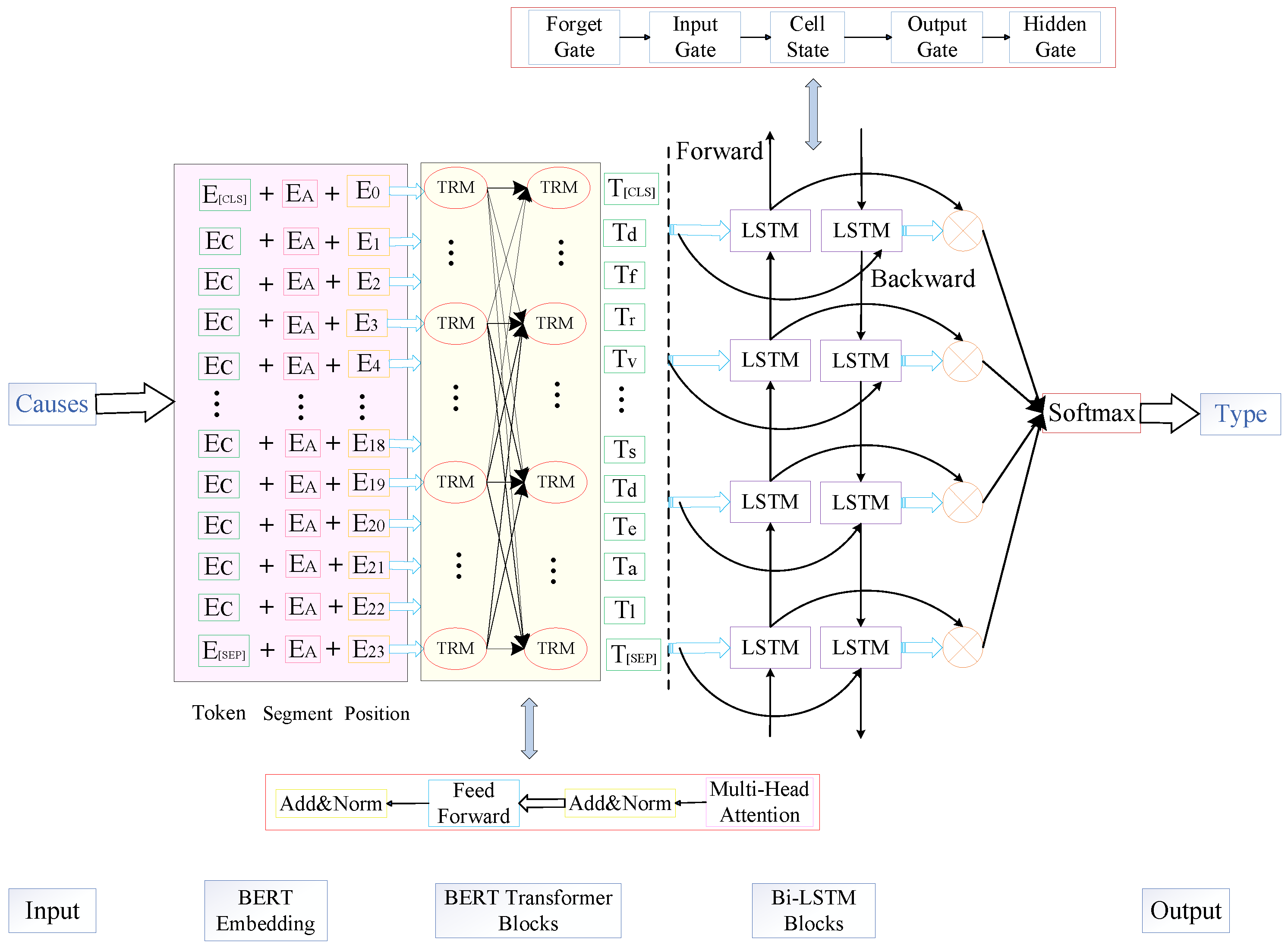
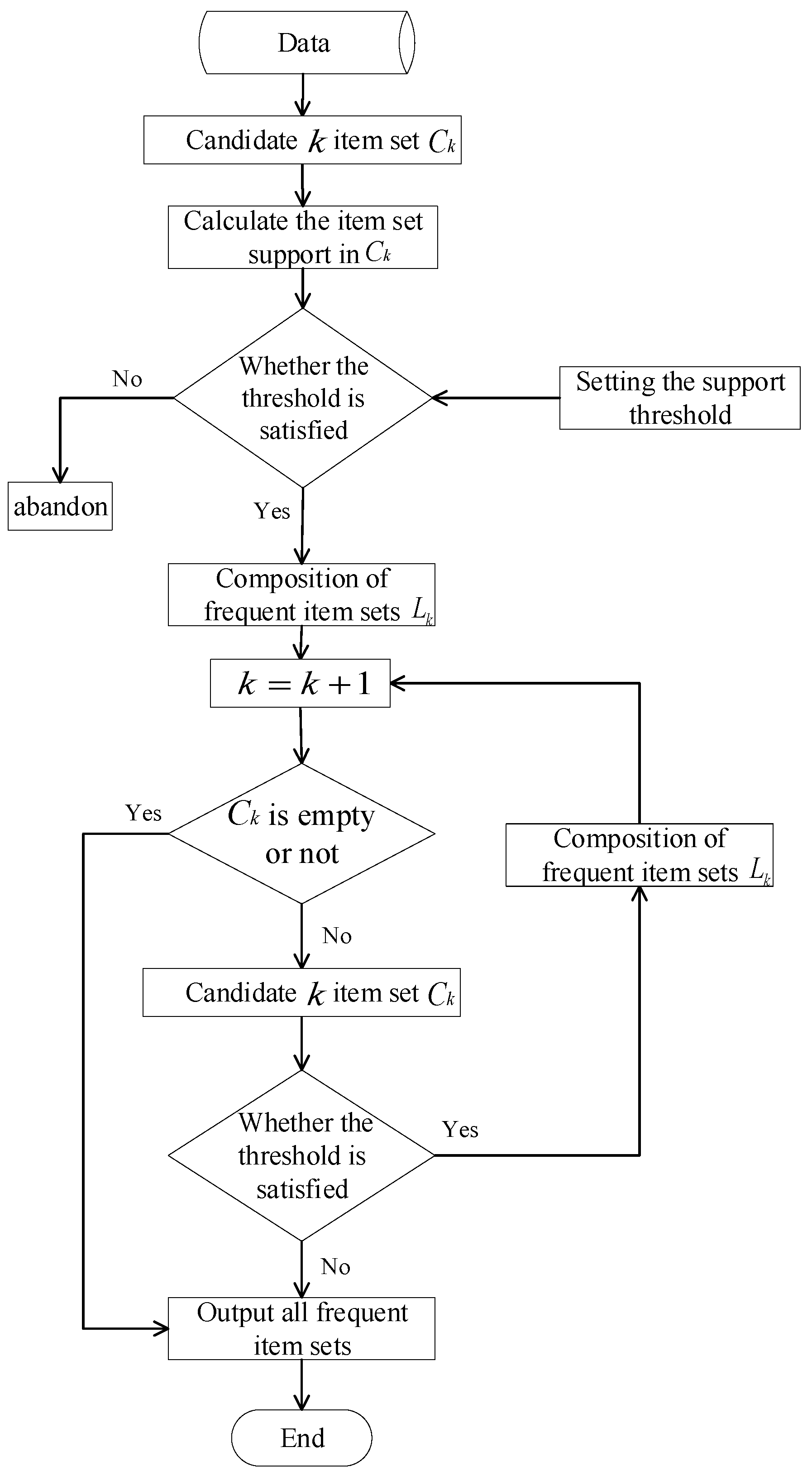
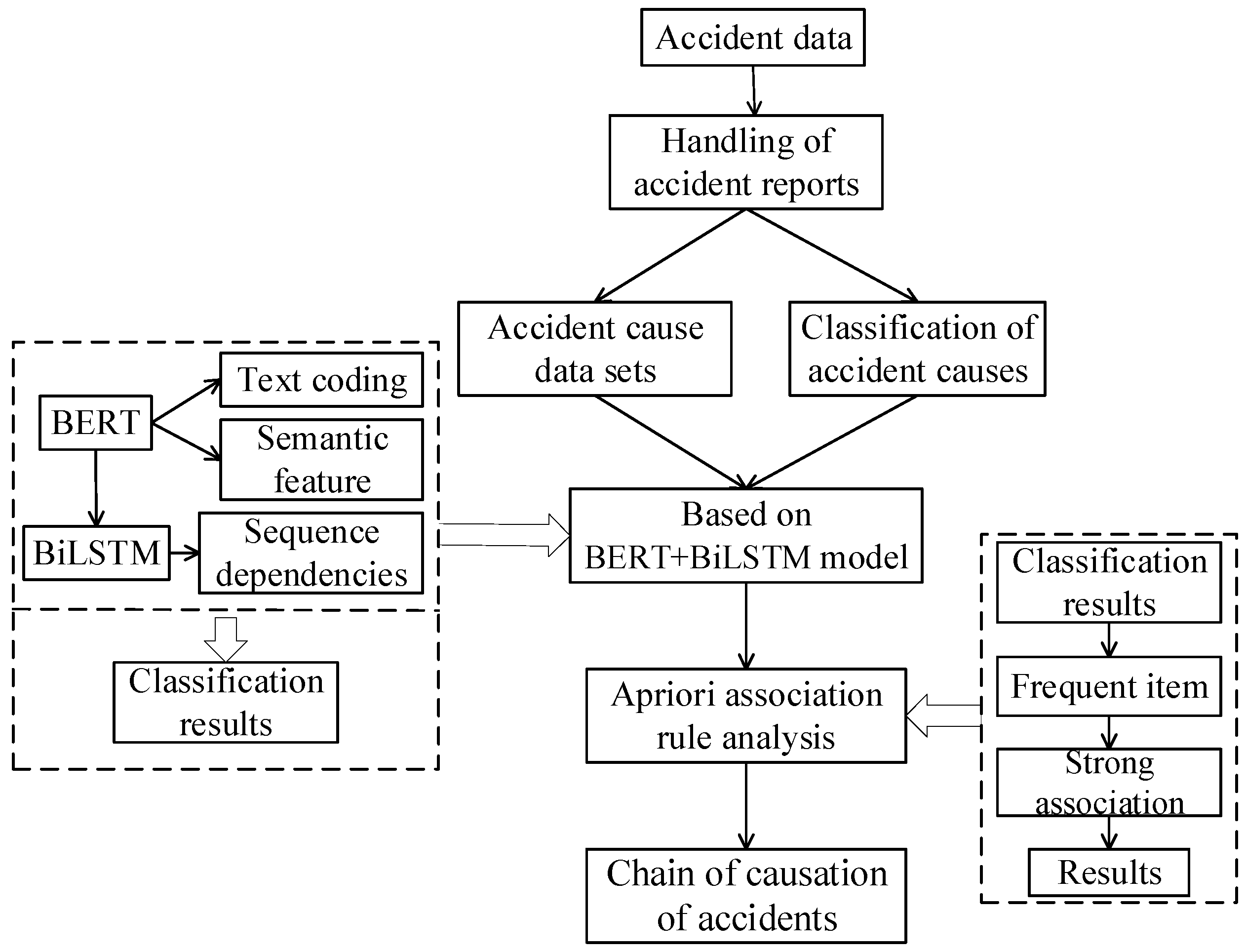
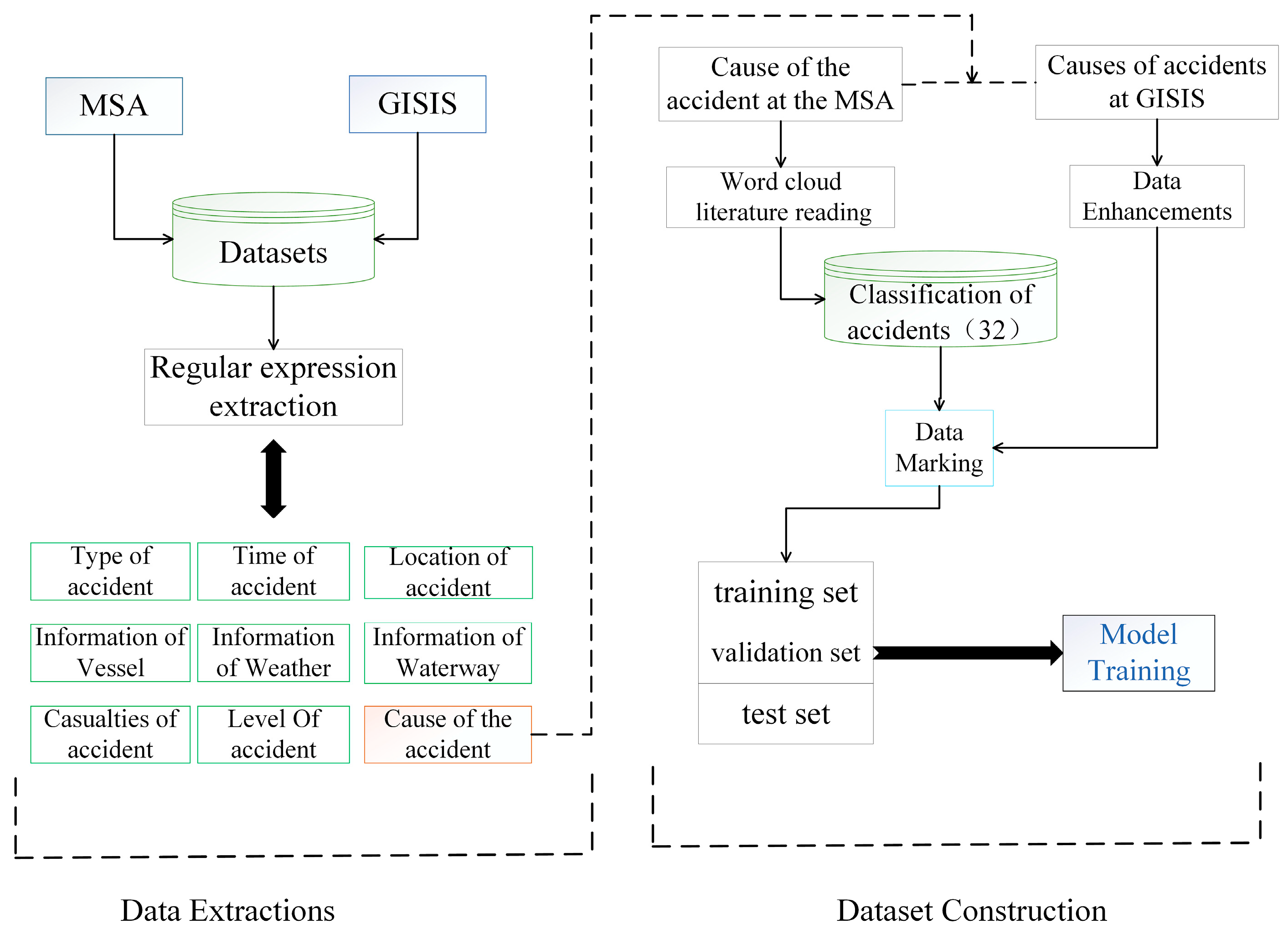
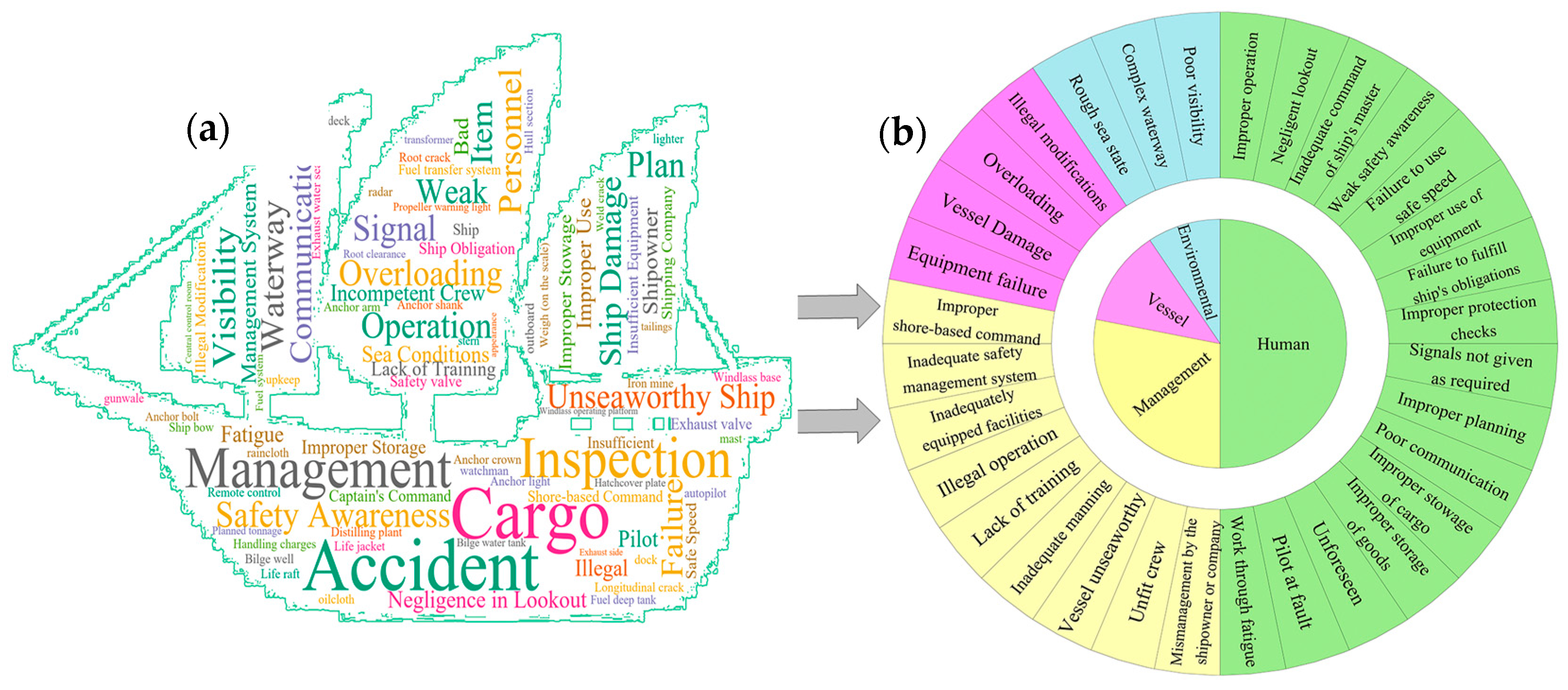
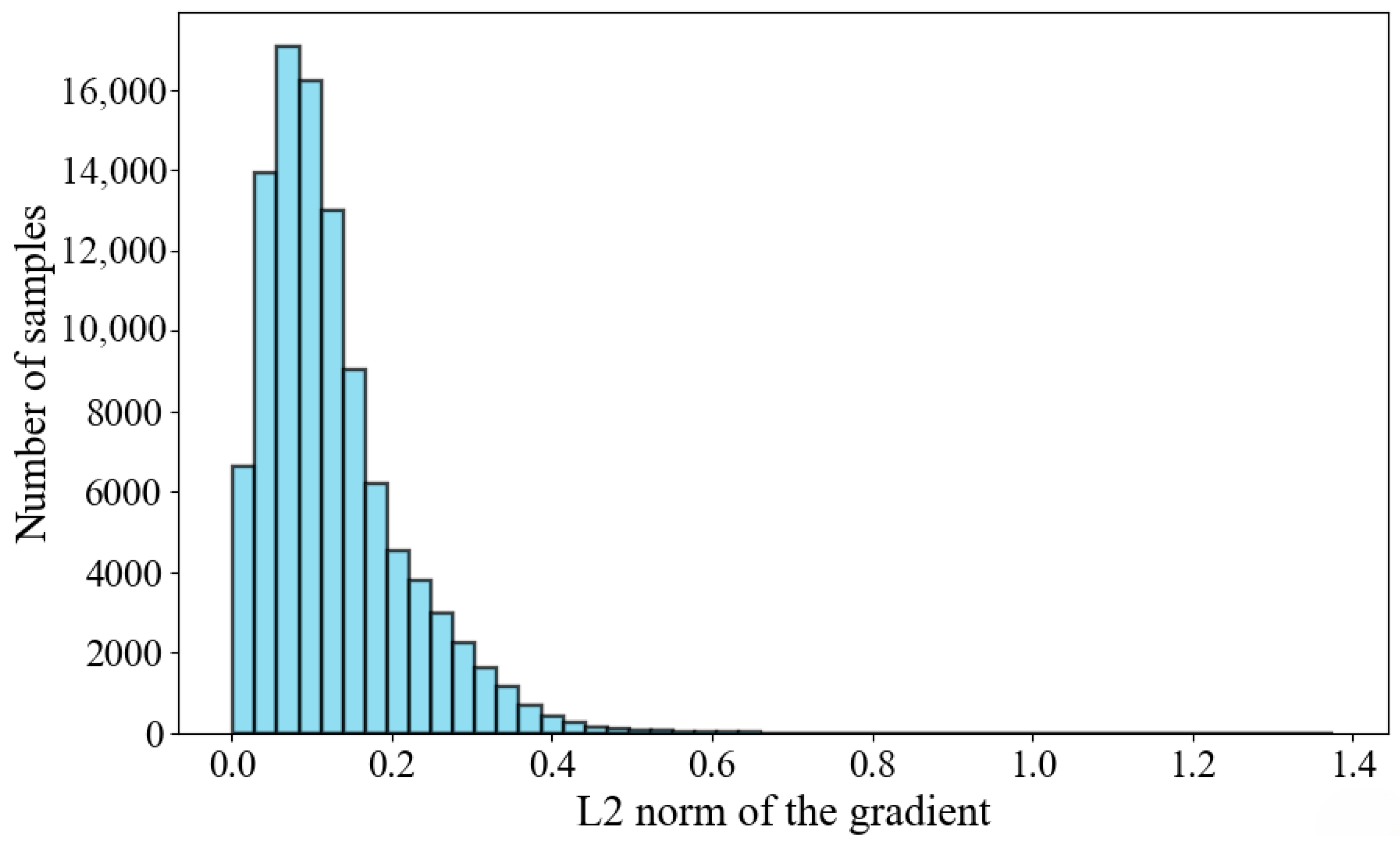
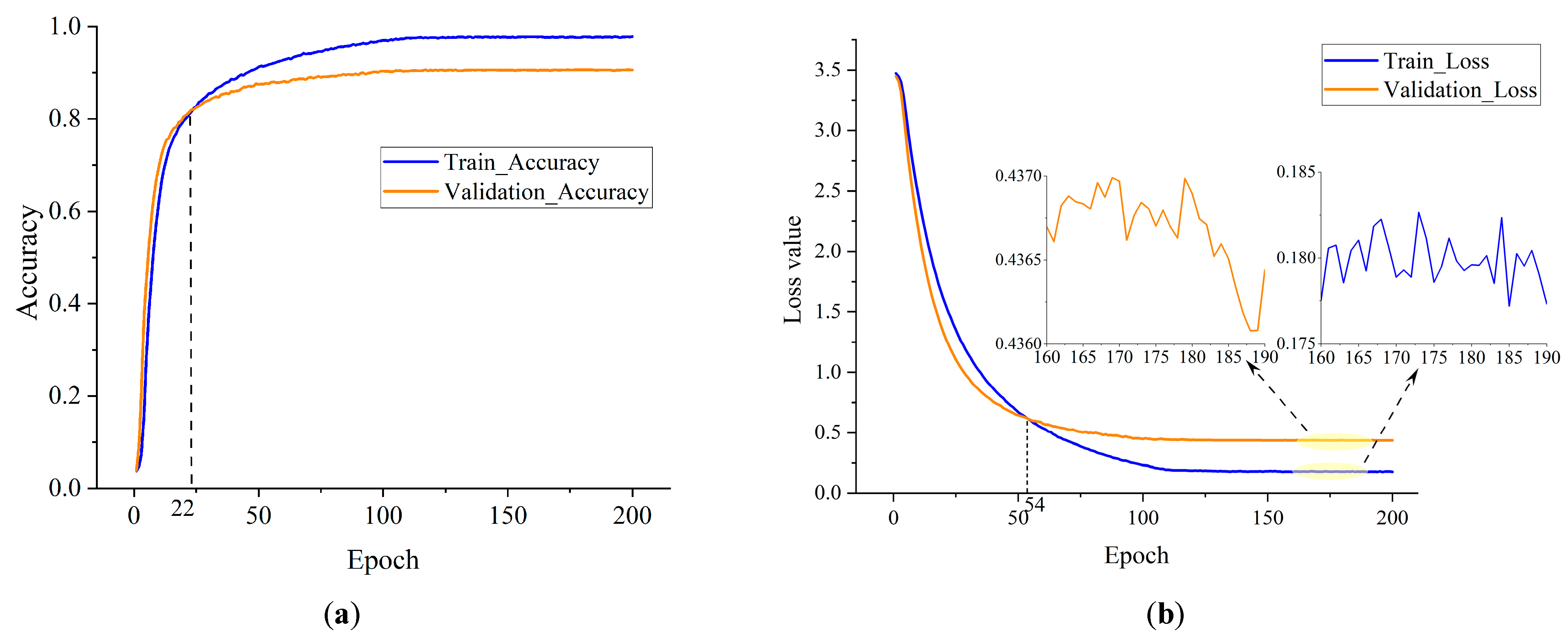
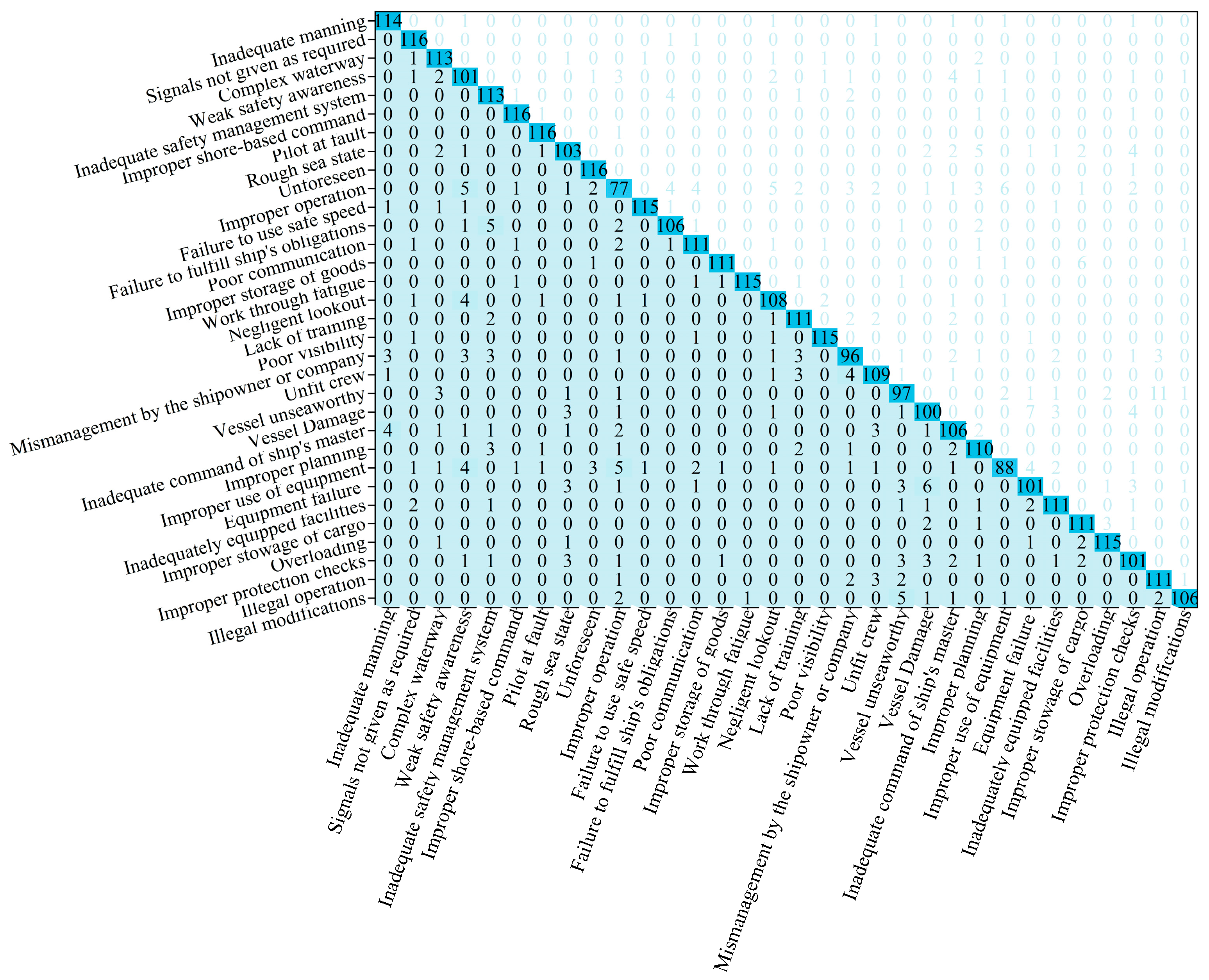
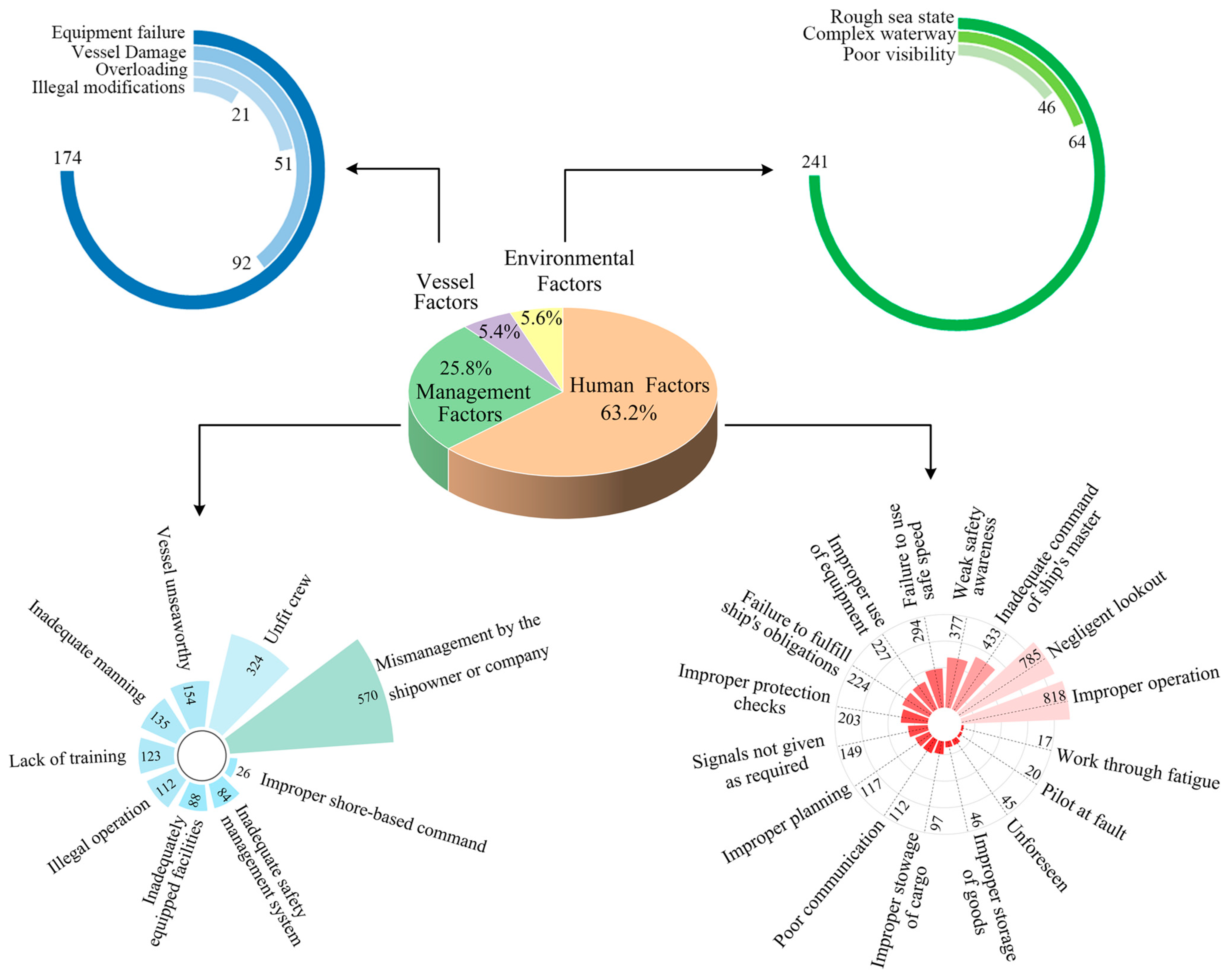
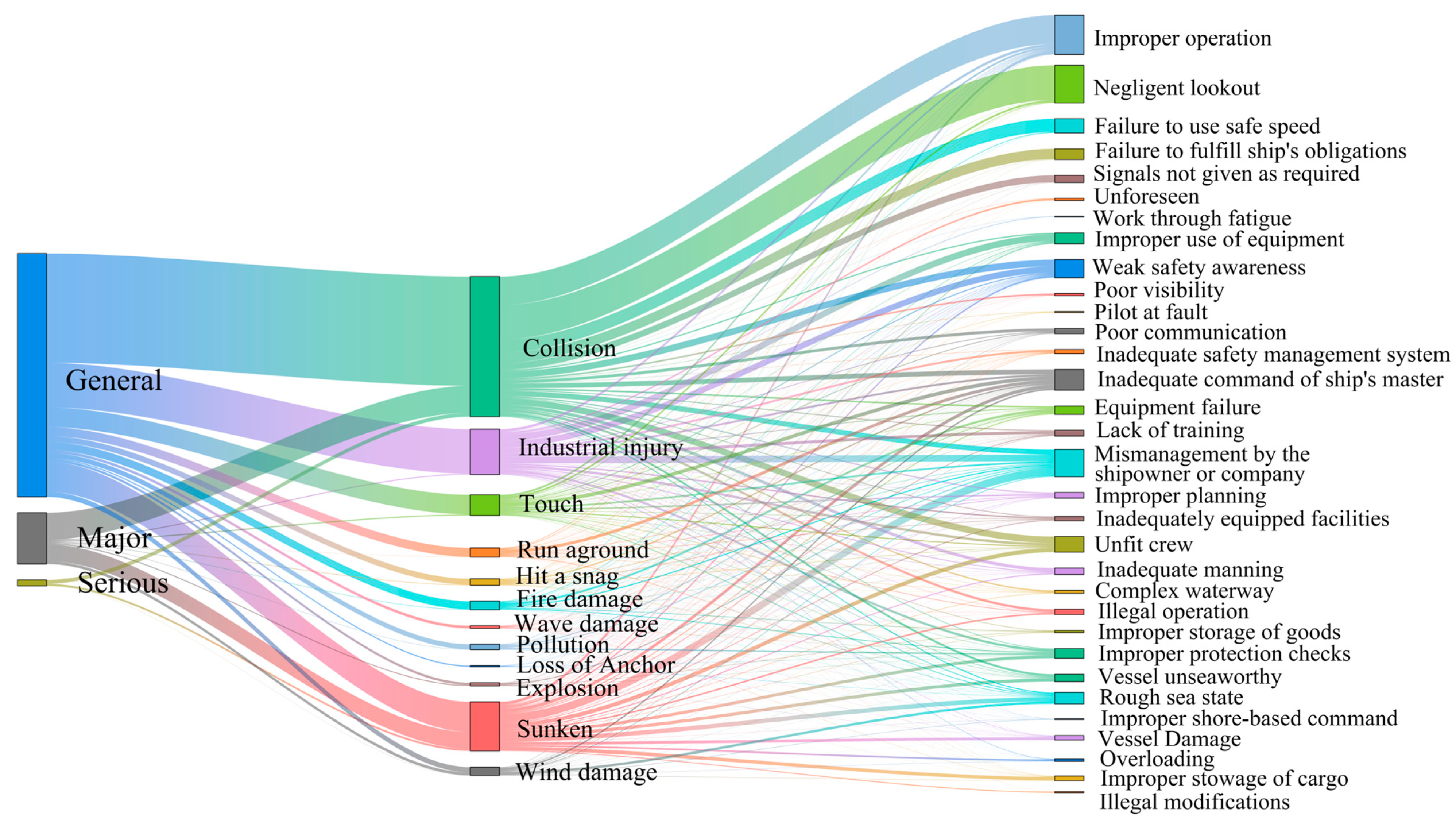
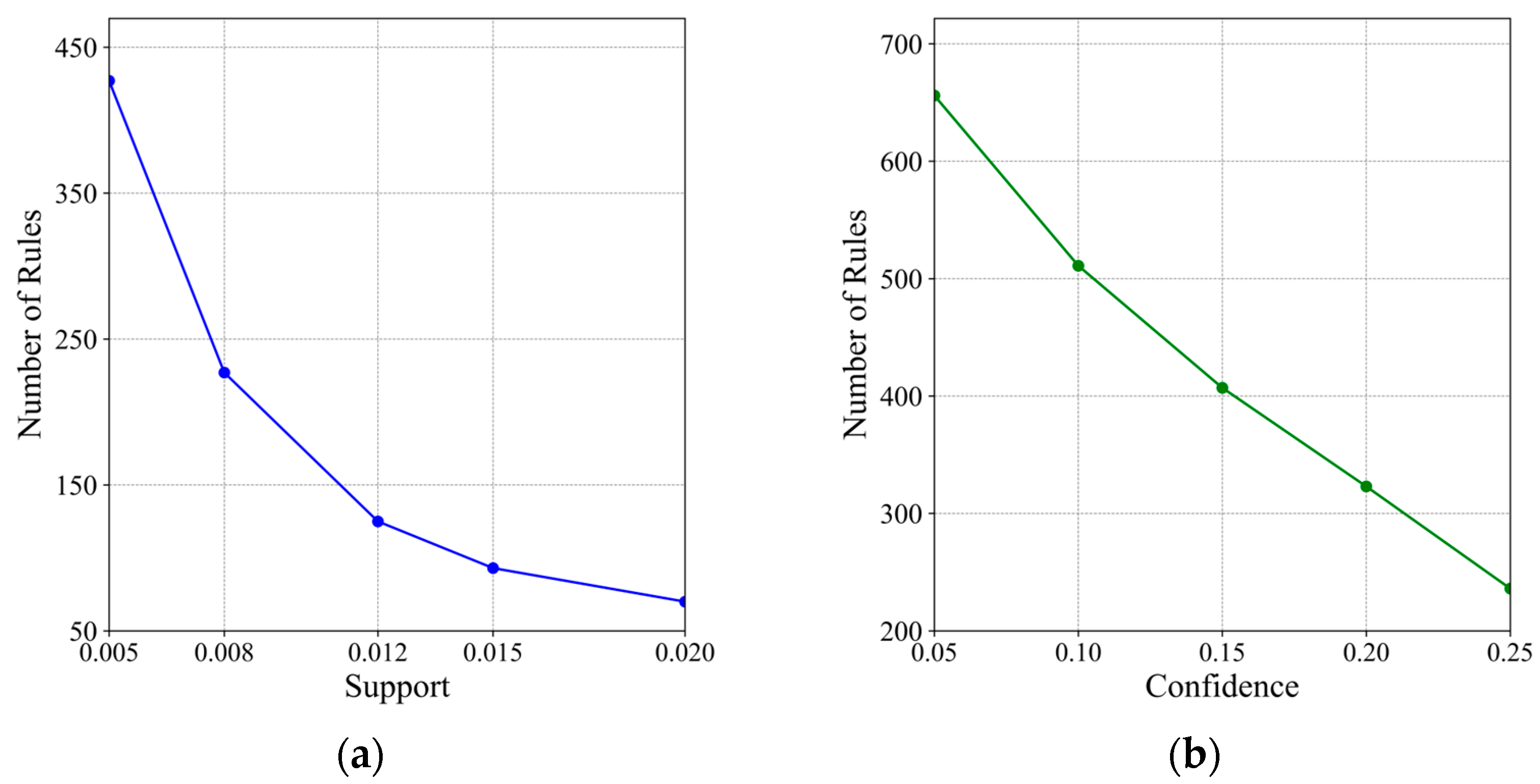

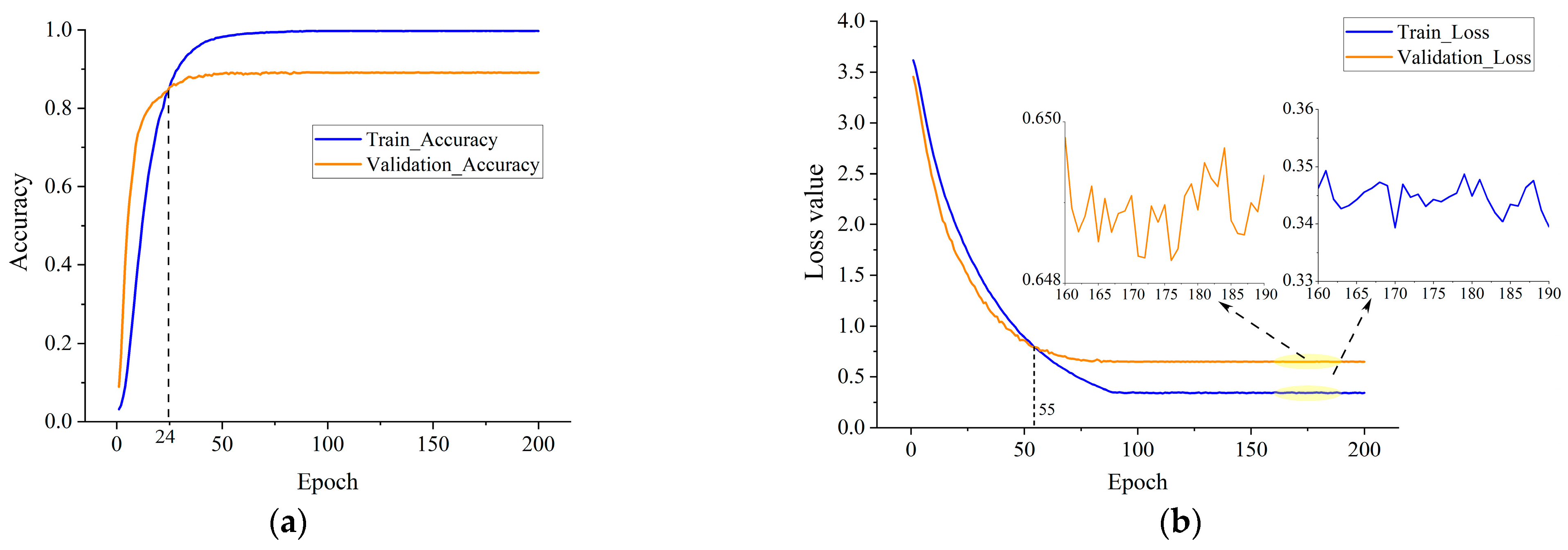
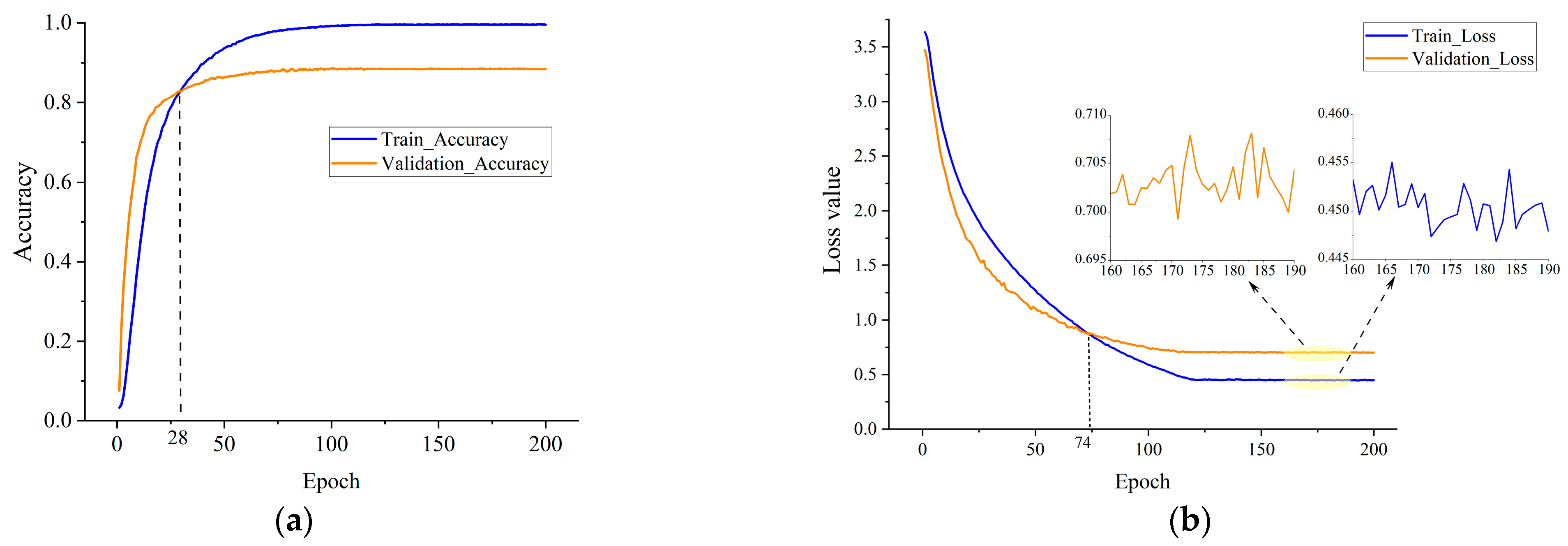
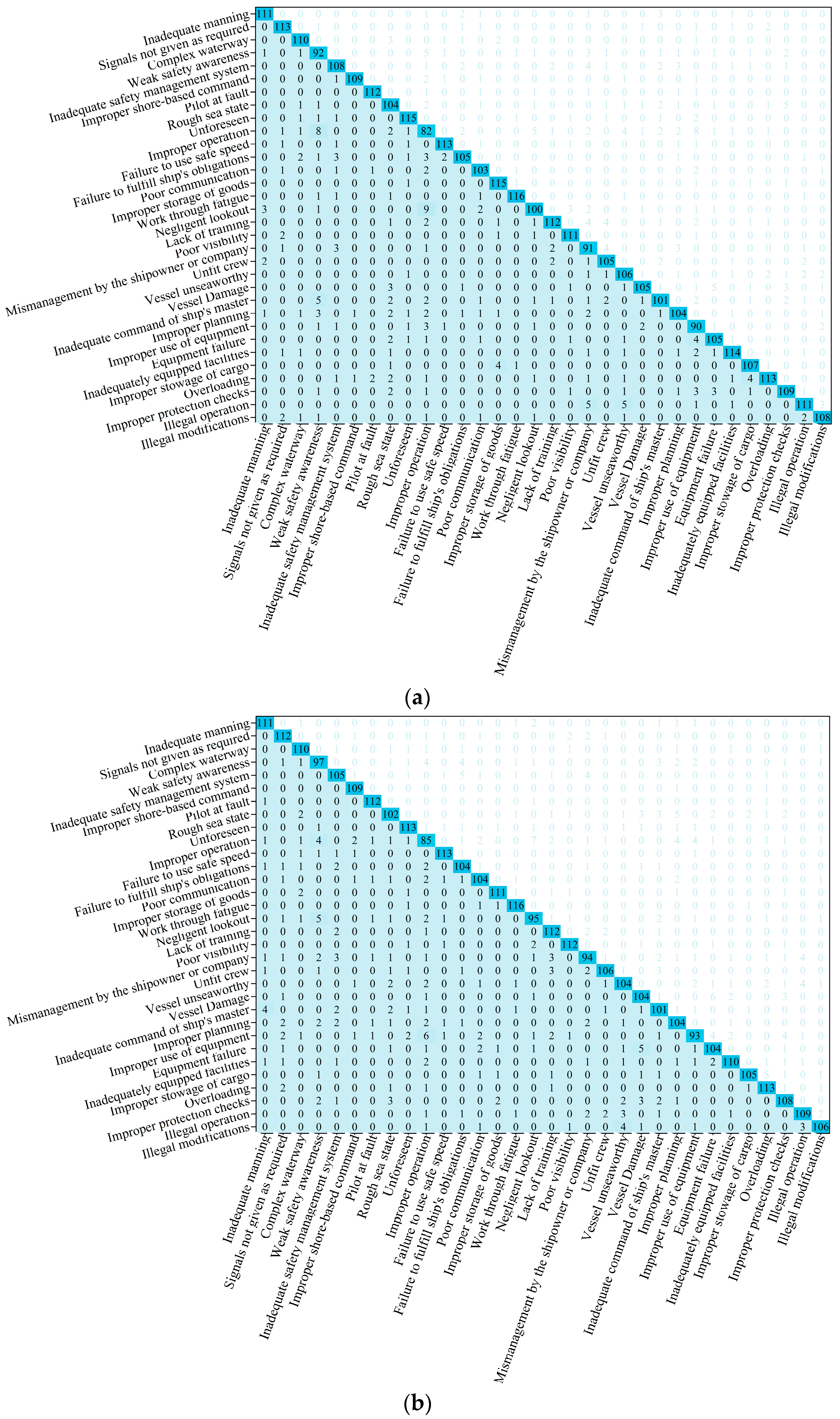
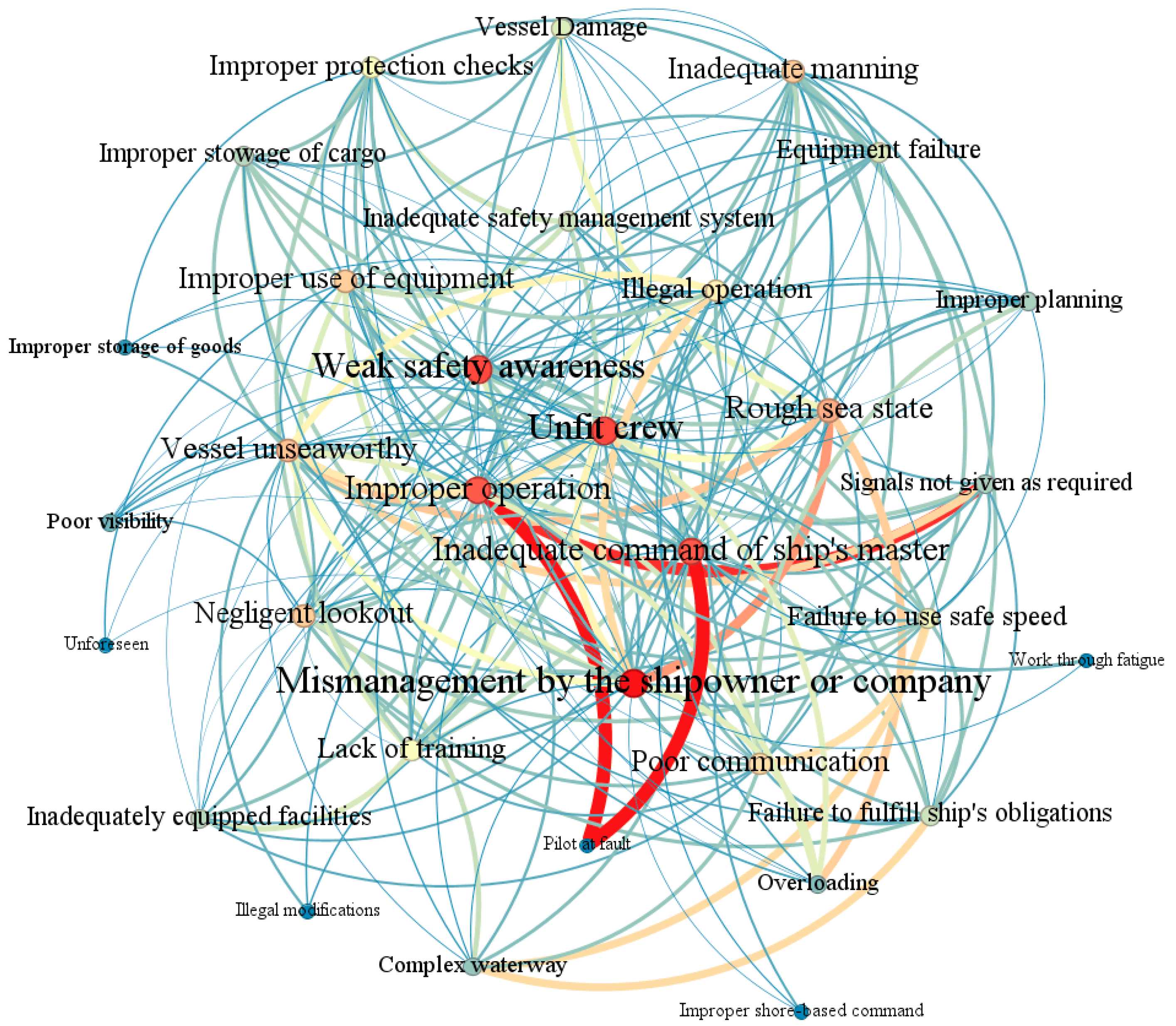
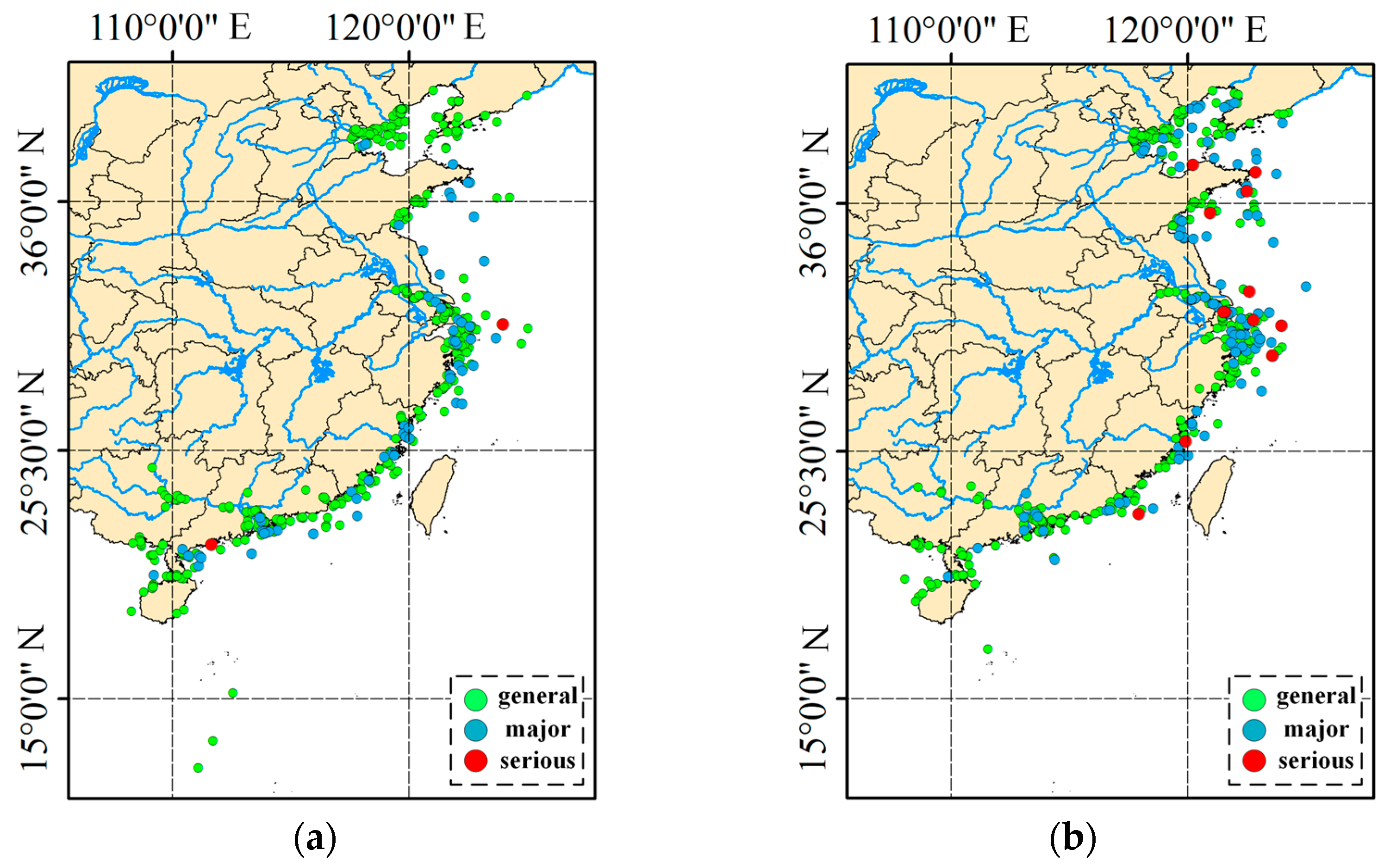
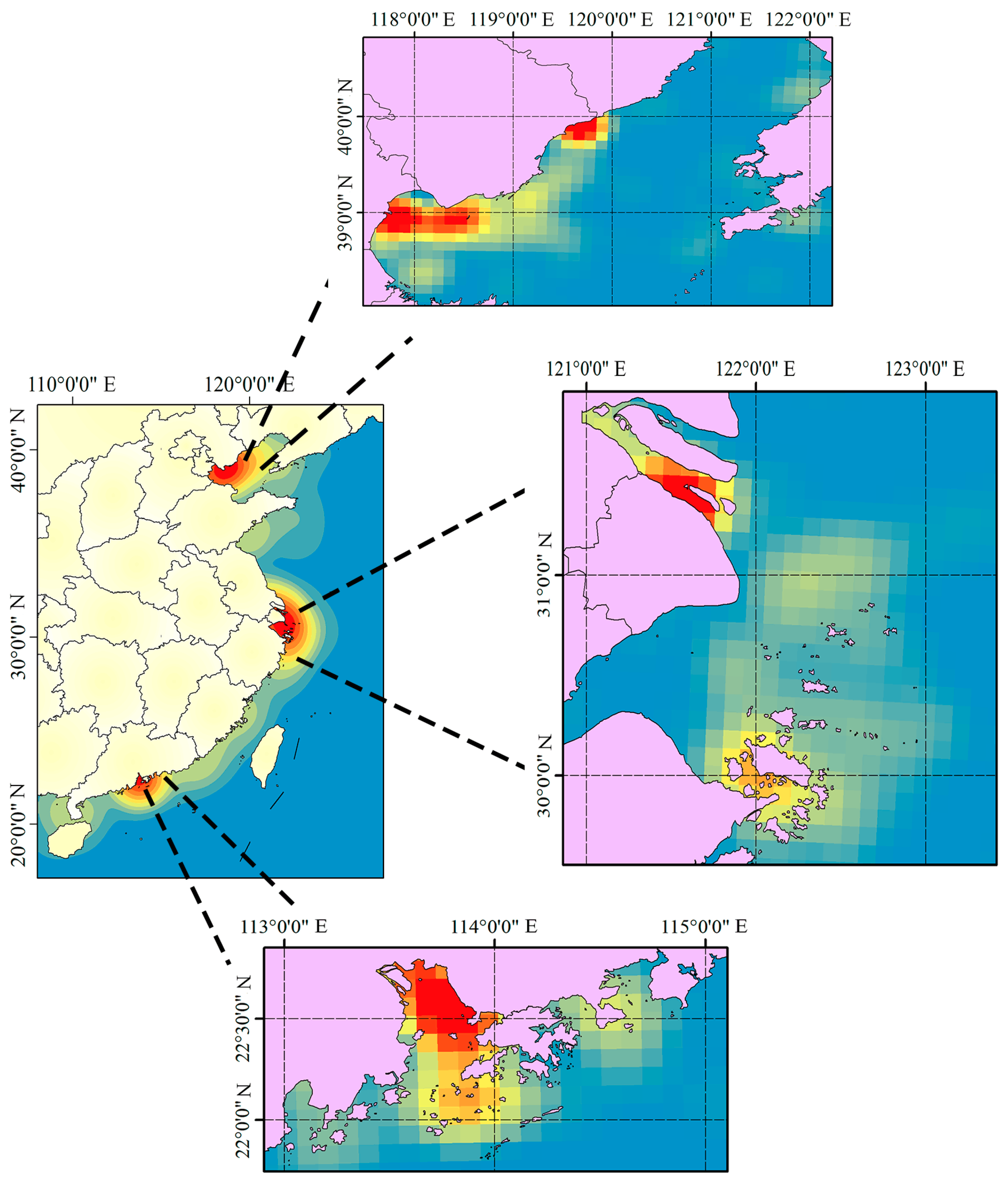
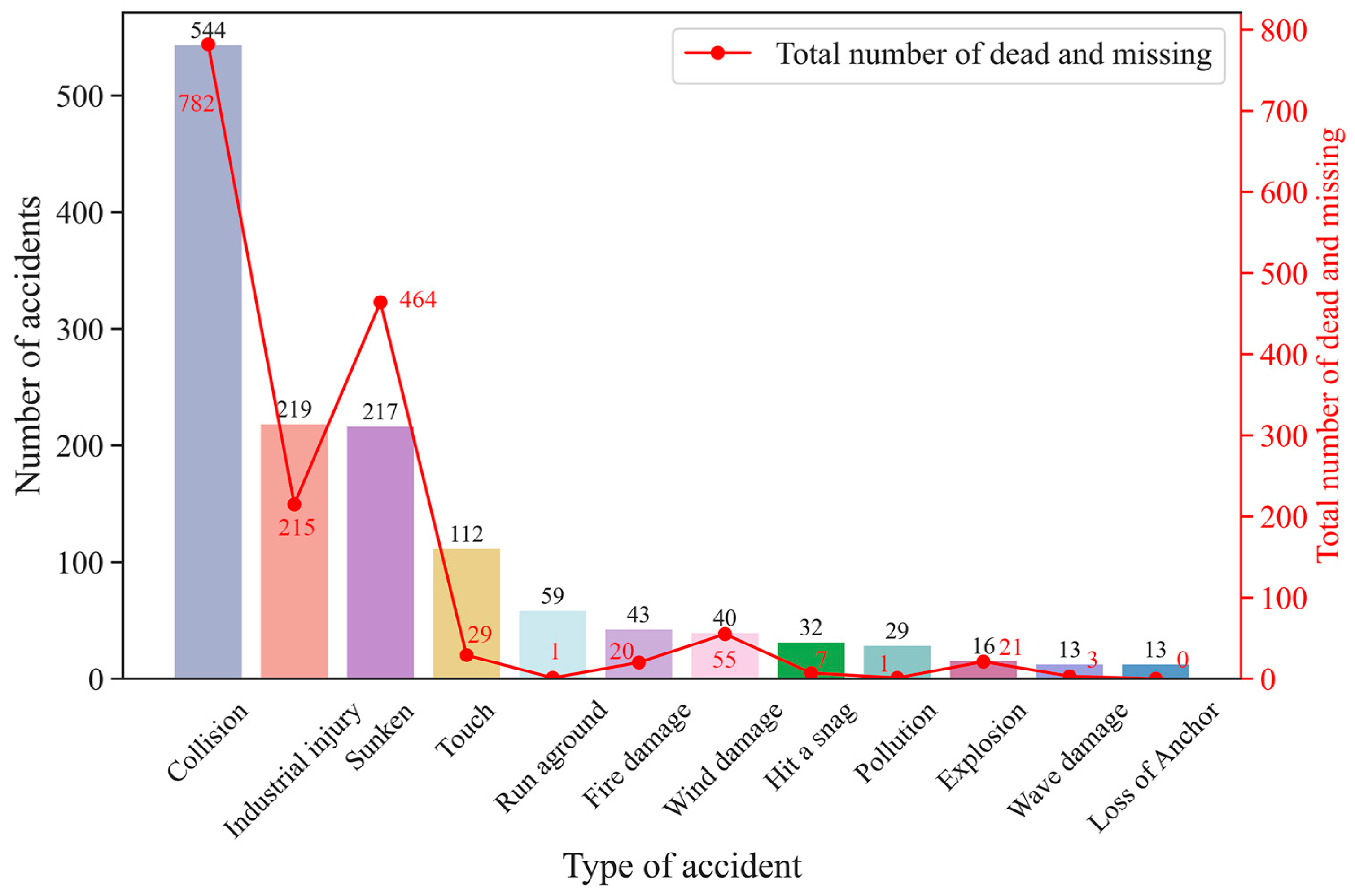
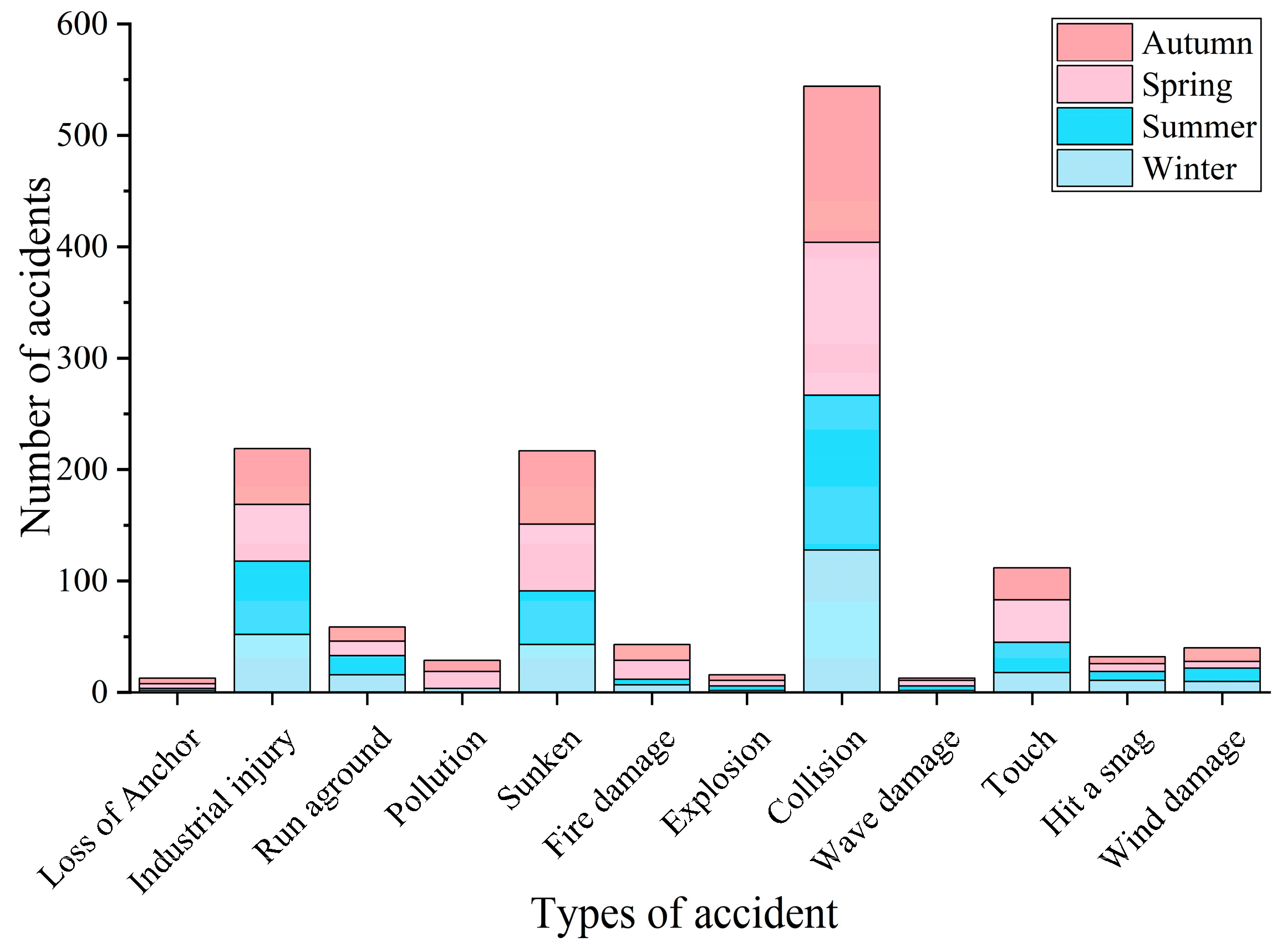
| Research Classification | Object of Primary Concern | Methodology | Research Focus |
|---|---|---|---|
| Subjective Factor | Human factor, Management factor | Case Study, Quantitative Analysis of HFACS, Structural Equation Modeling, Causality Analysis, and Statistical Analysis. | The critical role of human error and management deficiencies in accidents is analyzed, and the interplay among multiple factors is elucidated. |
| Objective Factor | Ship factor, Environmental factor | Statistical Data Analysis, Correlation Analysis, Empirical Analysis, Case Study Analysis, and Comprehensive Statistical Evaluation. | Analyze the influence of mechanical failures and environmental factors, such as low visibility, on the occurrence and severity of accidents. |
| Traditional Analysis Methods | Comprehensive Analysis of Accident Risk | Formal Security Assessment Method, Regression Model, Causal Model Combined with Cluster Analysis. | Assess accident risks and propose a conventional methodology for systemic risk management and accident prevention. |
| Data-driven Models | Multifactor Comprehensive Analysis | Bayesian Networks (BNs) and Their Optimization Methodologies, Fuzzy SWOT AHP, Reason-SHEL, DEMATEL. | Characterize and assess the complex interrelationships among factors involved in accidents to minimize subjective bias. Conduct dynamic analyses of human factors and causal mechanisms in accidents to systematically explore multi-factor interactions. |
| Deep Learning | Accident Text Information Extraction | Feature Extraction and Knowledge Mapping. | Improve the accuracy of accident risk prediction, achieve the extraction of information from accident report texts, and enable efficient identification of causal relationships. |
| Heading | Configuration Information |
|---|---|
| Operating system | Windows 11 |
| Programming language | Python 3.9 |
| Experimental platform | Jupyter Notebook |
| GPU | GeForce RTX4060Ti (8G) |
| CPU | Inter Core i5-12400F |
| Deep Learning Framework | PyTorch (CUDA 12.4) |
| Categories | Parameters | Test Loss Rate | Test Accuracy | Difference in Loss |
|---|---|---|---|---|
| Grads | 2.5 | 0.675 | 0.885 | 0.28 |
| 2.75 | 0.467 | 0.898 | 0.26 | |
| 3 | 0.695 | 0.875 | 0.43 | |
| Hidden layer | 64 | 0.645 | 0.890 | 0.49 |
| 128 | 0.467 | 0.898 | 0.26 | |
| 256 | 0.700 | 0.888 | 0.68 | |
| Batchsize | 16 | 0.708 | 0.883 | 0.56 |
| 32 | 0.467 | 0.898 | 0.26 | |
| 64 | 0.648 | 0.889 | 0.41 | |
| Droupout | 0 | - | - | 0.83 |
| 1 | - | - | 0.67 | |
| 2 | - | - | 0.26 | |
| Regularization | 1 | - | - | 0.54 |
| 2 | - | - | 0.26 |
| Sort Number | The Specific Cause of the Accident | Degree Centrality |
|---|---|---|
| 1 | Mismanagement by the shipowner or company | 0.9677 |
| 2 | Improper operation | 0.8710 |
| 3 | Weak safety awareness | 0.8710 |
| 4 | Unfit crew | 0.8387 |
| 5 | Inadequate command of the ship’s master | 0.8387 |
| 6 | Rough sea state | 0.6774 |
| 7 | Inadequate manning | 0.6452 |
| 8 | Vessel unseaworthy | 0.6129 |
| 9 | Poor communication | 0.6129 |
| 10 | Negligent lookout | 0.6129 |
| Sort Number | Cause Combination | Lift | Confidence | Support |
|---|---|---|---|---|
| 1 | Failure to use safe speed -> Negligent lookout | 2.23 | 0.81 | 0.13 |
| 2 | Signals not given as required -> Negligent lookout | 2.22 | 0.80 | 0.07 |
| 3 | Failure to fulfill ship’s obligations -> Negligent lookout | 2.13 | 0.77 | 0.09 |
| 4 | Pilot at fault -> Inadequate command of the ship’s master | 3.49 | 0.76 | 0.01 |
| 5 | Illegal modifications -> Mismanagement by the shipowner or company | 2.45 | 0.76 | 0.01 |
| Sort Number | Cause Combination | Lift | Confidence | Support |
|---|---|---|---|---|
| 1 | Inadequate manning, Improper operation, Failure to use safe speed -> Negligent lookout | 2.77 | 1 | 0.01 |
| 2 | Vessel unseaworthy, Signals not given as required -> Improper operation | 2.33 | 0.92 | 0.01 |
| 3 | Poor communication, Failure to fulfill ship’s obligations -> Improper operation | 2.33 | 0.92 | 0.01 |
| 4 | Pilot at fault, Improper operation -> Inadequate command of ship’s master | 4.1 | 0.90 | 0.01 |
| 5 | Signals not given as required, Failure to use safe speed -> Negligent lookout | 2.47 | 0.89 | 0.03 |
| Sort Number | Cause Combination | Lift | Confidence | Support |
|---|---|---|---|---|
| 1 | Work through fatigue -> Improper use of equipment | 4.29 | 0.53 | 0.01 |
| 2 | Illegal modifications -> Vessel unseaworthy | 3.73 | 0.37 | 0.01 |
| 3 | Inadequate safety management system -> Lack of training | 3.50 | 0.27 | 0.02 |
| 4 | Lack of training -> Inadequate safety management system | 3.50 | 0.20 | 0.02 |
| 5 | Pilot at fault -> Inadequate command of the ship’s master | 3.49 | 0.76 | 0.01 |
| Sort Number | Cause Combination | Lift | Confidence | Support |
|---|---|---|---|---|
| 1 | Inadequate command of ship’s master, Improper operation -> Pilot at fault | 9.07 | 0.15 | 0.01 |
| 2 | Pilot at fault -> Inadequate command of ship’s master, Improper operation | 9.07 | 0.53 | 0.01 |
| 3 | Vessel unseaworthy, Improper operation -> Signals not given as required, Unfit crew | 8.56 | 0.17 | 0.01 |
| 4 | Signals not given as required, Unfit crew -> Vessel unseaworthy, Improper operation | 8.56 | 0.27 | 0.01 |
| 5 | Signals not given as required, Vessel unseaworthy -> Unfit crew, Improper operation | 7.95 | 0.58 | 0.01 |
| Parameter | BERT | Pooling Mechanism + BERT | BERT + BiLSTM |
|---|---|---|---|
| Hidden Layer | BERT layer 512 | BERT layer 512 | LSTM layer 128 |
| Learning Rate | 1 × 10−6 | 1 × 10−6 | 1 × 10−6 |
| Dropout Layer | 3 | 3 | 2 |
| L1 Regularization | 1 × 10−8 | 1 × 10−8 | 5 × 10−10 |
| L2 Regularization | 0.05 | 0.01 | 0.05 |
| Gradient | 2.35 | 3.5 | 2.75 |
| Optimizer | AdamW | AdamW | AdamW |
| Activation Function | GELU | Mish | Mish |
| Batchsize | 32 | 32 | 32 |
| Model | BERT | BERT + BiLSTM | BERT + Pooling Mechanism | |||||||
|---|---|---|---|---|---|---|---|---|---|---|
| Evaluation Indicators | Precision | Recall | F1-Score | Precision | Recall | F1-Score | Precision | Recall | F1-Score | |
| Cause | ||||||||||
| Inadequate manning | 0.925 | 0.941 | 0.933 | 0.927 | 0.950 | 0.938 | 0.917 | 0.941 | 0.929 | |
| Signals not given as required | 0.934 | 0.926 | 0.930 | 0.944 | 0.975 | 0.959 | 0.889 | 0.918 | 0.903 | |
| Complex waterway | 0.932 | 0.924 | 0.928 | 0.911 | 0.942 | 0.926 | 0.909 | 0.924 | 0.917 | |
| Weak safety awareness | 0.821 | 0.786 | 0.803 | 0.821 | 0.842 | 0.831 | 0.836 | 0.829 | 0.833 | |
| Inadequate safety management system | 0.857 | 0.893 | 0.874 | 0.876 | 0.934 | 0.904 | 0.875 | 0.868 | 0.871 | |
| Improper shore-based command | 0.940 | 0.982 | 0.960 | 0.967 | 0.983 | 0.975 | 0.932 | 0.982 | 0.956 | |
| Pilot at fault | 0.949 | 0.974 | 0.961 | 0.975 | 0.992 | 0.983 | 0.949 | 0.974 | 0.961 | |
| Rough sea state | 0.846 | 0.825 | 0.835 | 0.880 | 0.837 | 0.858 | 0.857 | 0.810 | 0.833 | |
| Unforeseen | 0.927 | 0.935 | 0.931 | 0.943 | 0.991 | 0.967 | 0.911 | 0.919 | 0.915 | |
| Improper operation | 0.656 | 0.672 | 0.664 | 0.755 | 0.642 | 0.694 | 0.720 | 0.697 | 0.708 | |
| Failure to use safe speed | 0.942 | 0.950 | 0.946 | 0.975 | 0.958 | 0.966 | 0.934 | 0.950 | 0.942 | |
| Failure to fulfill ship’s obligations | 0.882 | 0.913 | 0.897 | 0.906 | 0.898 | 0.902 | 0.881 | 0.904 | 0.893 | |
| Poor communication | 0.920 | 0.888 | 0.904 | 0.910 | 0.925 | 0.917 | 0.889 | 0.897 | 0.893 | |
| Improper storage of goods | 0.958 | 0.927 | 0.943 | 0.974 | 0.925 | 0.949 | 0.949 | 0.895 | 0.921 | |
| Work through fatigue | 0.951 | 0.959 | 0.955 | 0.991 | 0.958 | 0.975 | 0.936 | 0.967 | 0.951 | |
| Negligent lookout | 0.813 | 0.877 | 0.844 | 0.871 | 0.900 | 0.885 | 0.841 | 0.833 | 0.837 | |
| Lack of training | 0.862 | 0.933 | 0.896 | 0.902 | 0.925 | 0.914 | 0.875 | 0.933 | 0.903 | |
| Poor visibility | 0.957 | 0.933 | 0.945 | 0.958 | 0.966 | 0.962 | 0.933 | 0.941 | 0.937 | |
| Mismanagement by the shipowner or company | 0.858 | 0.758 | 0.805 | 0.857 | 0.800 | 0.828 | 0.847 | 0.783 | 0.814 | |
| Unfit crew | 0.913 | 0.875 | 0.894 | 0.893 | 0.908 | 0.901 | 0.922 | 0.883 | 0.902 | |
| Vessel unseaworthy | 0.891 | 0.855 | 0.872 | 0.836 | 0.808 | 0.822 | 0.874 | 0.839 | 0.856 | |
| Vessel Damage | 0.854 | 0.882 | 0.868 | 0.855 | 0.833 | 0.844 | 0.860 | 0.874 | 0.867 | |
| Inadequate command of the ship’s master | 0.821 | 0.863 | 0.842 | 0.841 | 0.869 | 0.855 | 0.821 | 0.863 | 0.842 | |
| Improper planning | 0.846 | 0.867 | 0.856 | 0.833 | 0.917 | 0.873 | 0.825 | 0.867 | 0.846 | |
| Improper use of equipment | 0.891 | 0.720 | 0.796 | 0.863 | 0.739 | 0.796 | 0.845 | 0.744 | 0.791 | |
| Equipment failure | 0.861 | 0.882 | 0.871 | 0.856 | 0.842 | 0.849 | 0.860 | 0.874 | 0.867 | |
| Inadequately equipped facilities | 0.919 | 0.919 | 0.919 | 0.902 | 0.925 | 0.914 | 0.924 | 0.887 | 0.905 | |
| Improper stowage of cargo | 0.939 | 0.907 | 0.922 | 0.895 | 0.941 | 0.917 | 0.905 | 0.890 | 0.897 | |
| Overloading | 0.883 | 0.934 | 0.908 | 0.950 | 0.958 | 0.954 | 0.883 | 0.934 | 0.908 | |
| Improper protection checks | 0.858 | 0.879 | 0.869 | 0.828 | 0.842 | 0.835 | 0.850 | 0.871 | 0.861 | |
| Illegal operation | 0.881 | 0.902 | 0.892 | 0.874 | 0.925 | 0.899 | 0.893 | 0.886 | 0.890 | |
| Illegal modifications | 0.915 | 0.915 | 0.915 | 0.955 | 0.891 | 0.922 | 0.906 | 0.898 | 0.902 | |
| Accuracy | 0.887 | 0.887 | 0.887 | 0.898 | 0.898 | 0.898 | 0.883 | 0.883 | 0.883 | |
| Macro avg | 0.888 | 0.887 | 0.887 | 0.898 | 0.898 | 0.897 | 0.883 | 0.884 | 0.883 | |
| Weighted avg | 0.887 | 0.887 | 0.886 | 0.898 | 0.898 | 0.897 | 0.883 | 0.883 | 0.882 | |
| Accident Level | Number of Deaths (Missing) | Number of Injured | Direct Economic Losses |
|---|---|---|---|
| Extraordinary major accidents | More than 30 people | More than 100 people | More than 100 million RMB |
| Serious accidents | More than 10 people but less than 30 people | More than 50 people but less than 100 people | More than 50 million RMB and less than 100 million RMB |
| Major accident | More than 3 people but less than 10 people | More than 10 people but less than 50 people | More than 10 million RMB and less than 50 million RMB |
| General accidents | More than 1 person but less than 3 people | More than 1 person but less than 10 people | Less than 10 million RMB |
| Research Topics | Traditional Methods/Current Situation | Improvement Method (This Article) | Comparison and Improvement |
|---|---|---|---|
| Data processing | Quantitative risk analysis [58], relies on structured data and preset parameters [59]. | Enhancing the BERT model to directly extract deep semantic information from unstructured accident reports. | BERT offers a profound understanding of textual data, particularly in capturing complex causal relationships, thereby significantly enhancing the analysis of unstructured text [43,55]. |
| Classification of accident causes | Most studies employ structural rule analysis techniques, resulting in findings that tend to be relatively generalized. | Automatic classification is achieved using deep learning models that address four primary factors—human, management, ship, and environment—encompassing a total of 32 subcategories. | The classification granularity is refined, and when combined with data enhancement techniques, the model’s coverage and accuracy are improved, thereby providing more targeted data support for accident prevention measures [6]. |
| Accident cause analysis | Previous studies have predominantly emphasized human error as the primary cause of maritime accidents [7,60]. Most research relies on single-factor analysis and employs Bayesian network analysis for risk assessment; however, these approaches lack a comprehensive multi-factor perspective [12,23,61]. | Building on the BERT model, accident cause classification is refined and integrated with the Apriori association rule algorithm, thereby revealing the complex interactions among multiple factors and generating high-confidence association rules. | The in-depth analysis of human factors was further refined, emphasizing the critical role of safety awareness [62]. Additionally, a range of integrated solutions were proposed to address combined issues, such as the interplay between fatigue and equipment failure, as well as the link between illegal modifications and ship unseaworthiness [63,64]. |
| Accident trend research | Based on simple distribution analyses, research on the differences between accident types and regions remains limited [6]. | Visualization analysis—including heat maps and seasonal trend maps—reveals the distribution patterns of accident types, temporal trends, and regional characteristics. | Nighttime accidents are predominantly concentrated in coastal areas. Shipwrecks occur more frequently during winter, whereas collisions are more common in summer and autumn. These observations have led to the proposal of management recommendations that are both time-based and area-specific [16,65]. |
| Innovation and advantages | Traditional risk analysis methods, such as Bayesian networks and FSA, provide limited support for association rule generation, which hampers the capacity for dynamic analysis [21,58]. | The improved BERT model delivers deep semantic understanding and enables the automatic classification of diverse accident causes. | This paper excels in dynamic data mining, effectively integrating it with semantic analysis to substantially enhance the comprehensive management of multiple factors. |
Disclaimer/Publisher’s Note: The statements, opinions and data contained in all publications are solely those of the individual author(s) and contributor(s) and not of MDPI and/or the editor(s). MDPI and/or the editor(s) disclaim responsibility for any injury to people or property resulting from any ideas, methods, instructions or products referred to in the content. |
© 2025 by the authors. Licensee MDPI, Basel, Switzerland. This article is an open access article distributed under the terms and conditions of the Creative Commons Attribution (CC BY) license (https://creativecommons.org/licenses/by/4.0/).
Share and Cite
Zhao, Z.; Liu, X.; Feng, L.; Grifoll, M.; Feng, H. Causation Analysis of Marine Traffic Accidents Using Deep Learning Approaches: A Case Study from China’s Coasts. Systems 2025, 13, 284. https://doi.org/10.3390/systems13040284
Zhao Z, Liu X, Feng L, Grifoll M, Feng H. Causation Analysis of Marine Traffic Accidents Using Deep Learning Approaches: A Case Study from China’s Coasts. Systems. 2025; 13(4):284. https://doi.org/10.3390/systems13040284
Chicago/Turabian StyleZhao, Zelin, Xingyu Liu, Lin Feng, Manel Grifoll, and Hongxiang Feng. 2025. "Causation Analysis of Marine Traffic Accidents Using Deep Learning Approaches: A Case Study from China’s Coasts" Systems 13, no. 4: 284. https://doi.org/10.3390/systems13040284
APA StyleZhao, Z., Liu, X., Feng, L., Grifoll, M., & Feng, H. (2025). Causation Analysis of Marine Traffic Accidents Using Deep Learning Approaches: A Case Study from China’s Coasts. Systems, 13(4), 284. https://doi.org/10.3390/systems13040284







